The Whispering Vault by oriongates
| 1 | Part 1 |
| 2 | Part 2 |
| 3 | Part 3 |
| 4 | Part 4 |
| 5 | Part 5 |
| 6 | Part 6 |
| 7 | The Hunt, continued |
| 8 | Post |
| 9 | Post |
| 10 | Spooky Shadows |
Part 1
Original SA post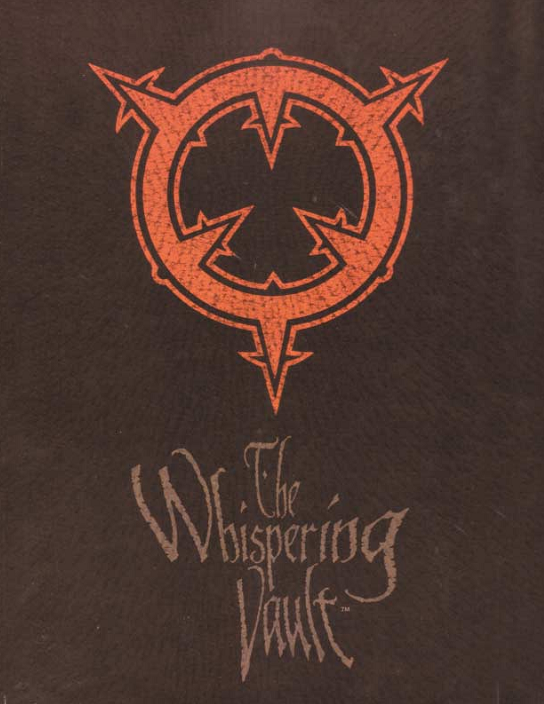
Ever wanted to play a cenobite super-hero? Want to play in a setting that's kind of like the baby of Clive Barker, David Cronenberg and Neil Gaimen? Well, that's the goal of Whispering Vault. Being honest, I really have no idea if the game is as awesome as I'm making it sound, it's been years since I've read it so I guess we'll find out together if it craps its pants or not.
The Whispering Vault: Part 1
Whispering Vault's opening has the slight air of pretension you get with a lot of late 90's/early 00's supernatural RPGs. Not quite as bad as something like the Everlasting fortunately. It also shows off its love of extremely elaborate page decoration.
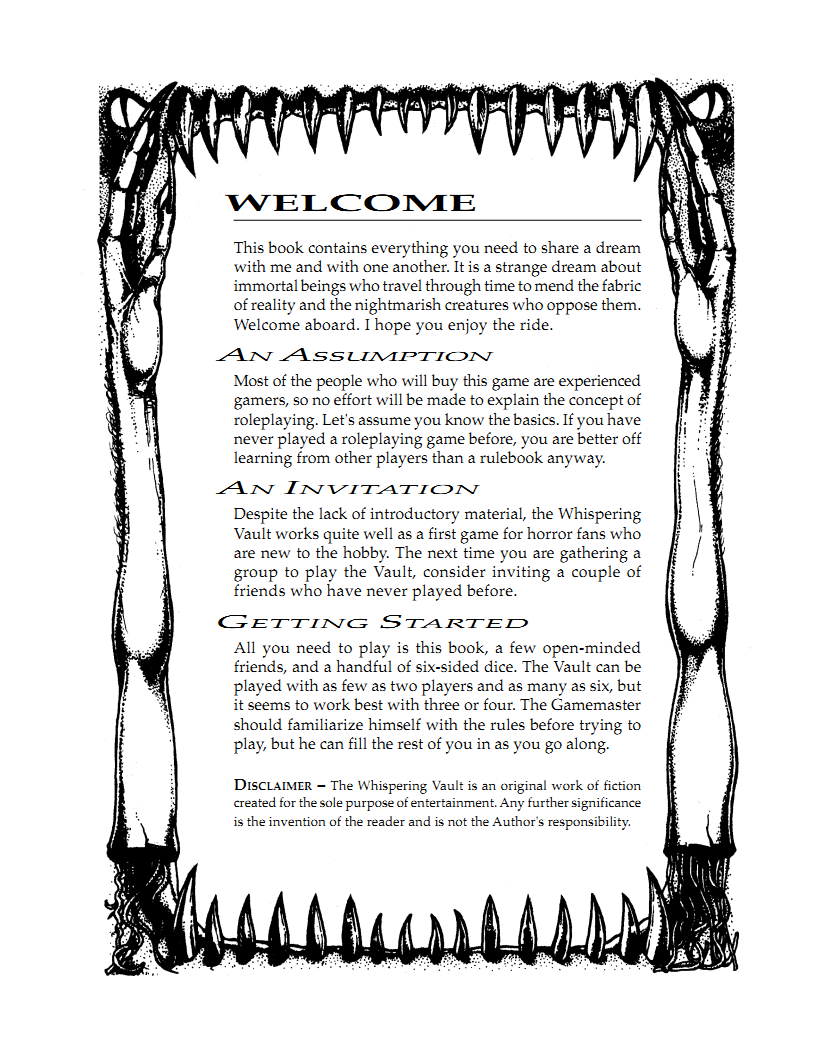
Note the standard "you are not a wizard in real life" disclaimer
One of the first things that strikes you is that the book is quite well-illustrated. Almost every page has a piece of nice, clean B&W art and while the content might occasionally range outside of "surreal horror" and into goofy territory it's overall very well done. So, if nothing else it's worth looking at.
The Other thing that you Notice is That there Are A Lot Of Words With capital Letters thrown Around the Place. It definitely makes the common RPG mistake of throwing a ton of unexplained jargon right at your face first thing.
The very first semi-IC "character pitch" we get mentions you found out about the Unseen, but none of the Unenlightened believed you and then you learned that you lived in the Realm of Flesh but beyond the Mundane (is that not the Realm of Flesh?) there is a Realm of Essence full of Ancient Mysteries and Unseen entities called the Unbidden and their Minions who come into the Realm of Flesh through Vessels from across the Rift. Then there are the Stalkers who hunt the Unbidden at the behest of the Primal Powers and casting them into the Vault and now you have become one of their Circle.
What is even The Fuck?
Fortunately the next section explains some of this. Here's the breakdown.
The normal, human world is the Realm of Flesh. There's the standard "safe within your comfortable lies" bullshit you get with any secret supernatural setting. Those who know the dark truths about the universe call themselves the Enlightened. The big Truth of the setting is that the world of Flesh is not all that there is.
The Realm of Flesh is bound by fairly concrete physical laws that allow things like life and physics to happen (except when they don't). There is also the Realm of Essence which is a more surreal, dreamlike place which has little to no set rules. It's worth noting that the Realm of Essence does not seem to be an "afterlife" for beings from the Realm of Flesh, in fact it seems like the two are not meant to interact at all.
In between the Realms is a "Neitherspace" inhabited by hordes of creatures called Shadows who are capable of interacting with both Flesh and Essence, but apparently don't merit a Realm of their own.
In the next paragraph "The Rift" is mentioned which is presumably the same as the Neitherspace, but that is not clarified. The Rift separates the Realms of Flesh and Essence and some beings of Flesh are capable of catching glimpses of the Realm of Essence across the Rift. These people are called Sensitives and the things they see are called the Unseen, and form the basis of most human mythology.
Then things get a little confusing, because the original implication seems to be that the Unseen are glimpses of the Realm of Essence seen across the Rift but then it starts talking about Shadows the beings in the Rift (or the Neitherspace?). You see apparently Shadows sometimes get Awakened by an experience that inspires them to try and get into the Realm of Flesh where they pose a danger to normal folks.
But the biggest threat is the Unbidden, who come to the Realm of Flesh (from...?) to fulfill "inhuman passions". They Awaken Shadows, turning them into Minions by binding them to physical vessels.
Humanity has protection from both of these threats from Stalkers who defend the Realm of Flesh by Hunting the Unseen (I thought the Unseen were things that only Sensitives saw?). Stalkers are Chosen for reasons unknown even to the Enlightened, but most of them are both Enlightened and Sensitive and have already fought the Unseen as a mortal. When the time is right the Stalker-to-be is Chosen and their humanity is forged into five Keys of Humanity which serve as their badge and allow them to return to the world of Flesh.
So...yeah. Clarity is not one of the Whispering Vault's strong suits. The summary above covers two pages of intro text from before the first chapter even starts and we already have 20 Important Capitalized Words (assuming I didn't miss one or two in that count).
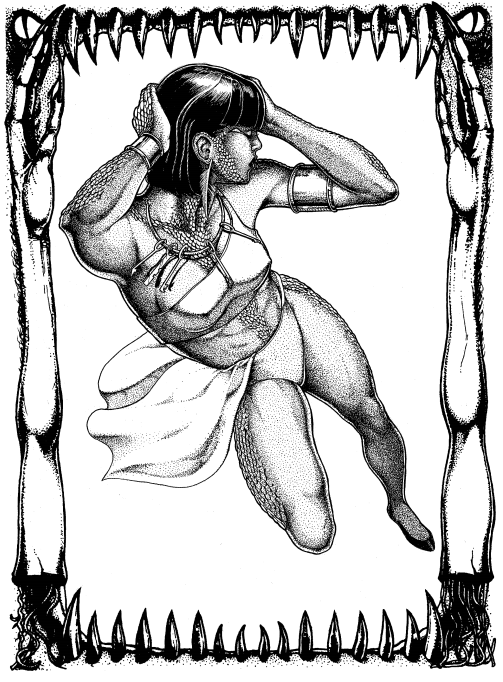
The intro isn't quite over yet, now we've got a bit more talk about what happens when you are Chosen:
When you are Chosen you transcend Flesh and the true nature of the universe is revealed to you. Sort of, apparently there are very few Chosen who fully comprehend the ancient mysteries (Ancient Mysteries was capitalized before, not sure why it isn't now). But even the most ignorant Stalker has a greater comprehension than the most enlightened (also not capitalized any more for some reason) mortal scholar.
Creation and Armageddon are part of a cosmic Cycle consuming and recreating both Realms forever and ever. Very few entities have what is called Persistent Essence required to survive Armageddon and live through multiple Cycles. These are called the Primal Powers. After Armageddon there is nothing but the Powers floating in the void and they invariably hunger for sensation and stimulation and think on their memories of past Cycles. This gives birth to the Aesthetics, beings of pure Essence (aren't all beings from the Realm of Essence beings of pure Essence?) whose imagination causes things to be created. Through their collective mind they Dream the Realm of Flesh.
Dear god this is a fucking complicated creation cycle.
As a result, many Enlightened also refer to the Realm of Flesh as the Dream (oh my god! why do you have so many names for the same thing?! So far the human world has been called the Realm of Flesh, the Mundane and the Dream and I bet there's more to come) and the act of the Aesthetics creating the mortal world as Dreaming. Magic, as humans understand it, is the process of influencing the Aesthetics to cause them to Dream something different (which, I must admit, is a creative explanation for magic).
Like mortal Sensitives some Aesthetics can gaze across the Rift and see the Realm of Flesh and become tempted to journey there to enjoy themselves. As Dreamers in the Realm of Flesh they see their Visions come to life but if they gaze too long at the realm of Flesh they become corrupted and develop a passion for Flesh. These perverse desires are forbidden. However, corrupted Aesthetics will eventually give in to temptation and cross the Rift in order to indulge, becoming one of the Unbidden.
By the way, I should mention that despite the squicky phrasing this game does not seem to be going the Black Tokyo route, so we can all let out that collective breath we were holding. Although there's a lot of body horror on the schedule it doesn't seem like Whispering Vault is bound on the train to Rape-Town.
The absence of an Aesthetic creates flaws in the Dream, called Enigmas by the Enlightened. Enigmas are basically any sort of supernatural phenomena and while they may not be physically harmful they are dangerous if they are not Mended because the Corruption will spread and threaten the Dreaming. To protect the Flesh from the Unbidden the Powers grant some mortals Essence to become Stalkers whose humanity allows them to safely travel to the Realm of Flesh and capture the Unbidden and Mend the Enigmas.
Capitalized Word Count: 30

Chapter 1: Character Creation
Finally things get a little bit more straightforward as we shift towards the mechanics.
In case it wasn't clear (and honestly, it probably wasn't) players in the Whispering Vault take the role of the Stalkers whose job it is to hunt down and retrieve the Unbidden and clear up any messes they've left behind. You were a mortal originally and those origins probably shape how you think even now that you are no longer a being of Flesh. However, you are also an immortal weirdo now and you aren't limited by normal human biology, psychology or morality anymore.
The "fluff" of character creation is handled via a series of questions:
* When and where were you born? Time is an illusion of Flesh, so Stalkers can potentially come from any time period. You could be a newbie stalker freshly plucked from a tribe in 3000 BC alongside an experienced Hunter who was a 1930's gangster in life. It notes that its possible to play characters from the future but since this demands the GM creating a timeline into the future this is discouraged.
* Who were you in life? The basics of your mortal life. Were you a cop? A hobo? A revolting peasant? It's generally important that you have some experience with the Unseen, making classic lovecraftian investigator-style professions (reporter, antiquarian, scholar, archeologist, etc) likely, but not necessary.
* Why did you hunt the Unseen? Did they kill your dad? Eat your dog? What drove you to pursue the Unseen instead of running from them?
* How were you recruited? Just what it sounds like. It does come with one of the goofier pictures in the book:
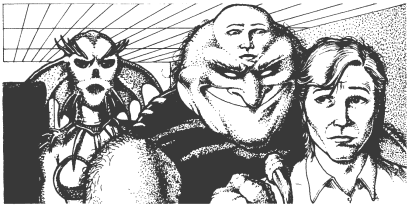
The concerned glance being shared between 2nd Head and Normal Guy is what sells it.
* What does your Avatar look like? When a Stalker is Chosen and their Flesh is removed they become an expression of spirit called an Avatar. The Avatar is your Essence-form and while it is often based on your mortal life to some degree it is not limited by the laws of physics or the constraints of flesh. It is noted that your appearance is just that, you are as strong or tough or whatever as your stats say you are and a towering giant may be weaker than a tiny child.
* What does your Domain look like? Your Domain is your home in the Realm of Essence and like your Avatar it is customized to suit your tastes by the Architecture of Essence. It is noted that the best Domains are outrageous and epic in theme, although rarely much bigger than a city.

Becoming a Stalker gives you the power to launch a Hand out of your Chin.
After that we get to the actual mechanical bits. As beings of Essence, Stalkers don't have physical stats, only mental ones. You get 22 points to divide among 4 stats:
Awareness: Perceiving things, physically and supernaturally. This stat determines the number of Disciplines (special abilities) you get.
Insight: Your ability to understand things intuitively. This determines the number of Skill Bonuses you have available.
Presence: Force of personality and charisma. This determines what Servitors you have access to (basically the Stalker version of Minions)
Willpower: Determination and self-control. This determines how powerful your Vessel is.
A 2-3 in a stat is "unremarkable" but there's not actually a maximum stat bonus listed for any of these in the rules. Reading between the lines seem to imply that an 8 is as high as things go...but its never outright stated.

Then we get into the stuff derived from your main Attributes.
Disciplines are your special powers available in the world of Flesh and new PCs get one Discipline per point of Awareness, but you can also Master a Discipline allowing you to perform special moves called Inspirations. This costs twice as many Discipline points. The exact effects of Disciplines and what Inspirations do are covered elsewhere and we are provided only with this summary:
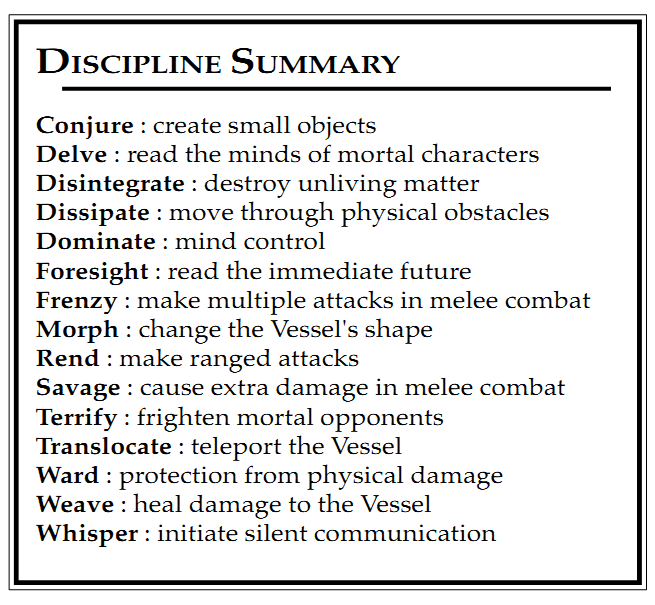
Servitors are "phantoms of Essence" which are apparently not the same thing as Shadows but are still able to appear in the Realm of Flesh with Stalkers. You can be linked to one Servitor per point of Presence (double cost to Master one). Servitors are summoned as a special action using the Evocation skill and is so difficult that it inflicts damage to your Vessel when you do so. Like Disciplines you can choose to Master a Servitor which means that you won't take damage when you successfully summon one. There is a list of Servitors who tend towards dumb names and several are notably redundant when compared to Disciplines, although we're given no hard stats to compare the two yet.
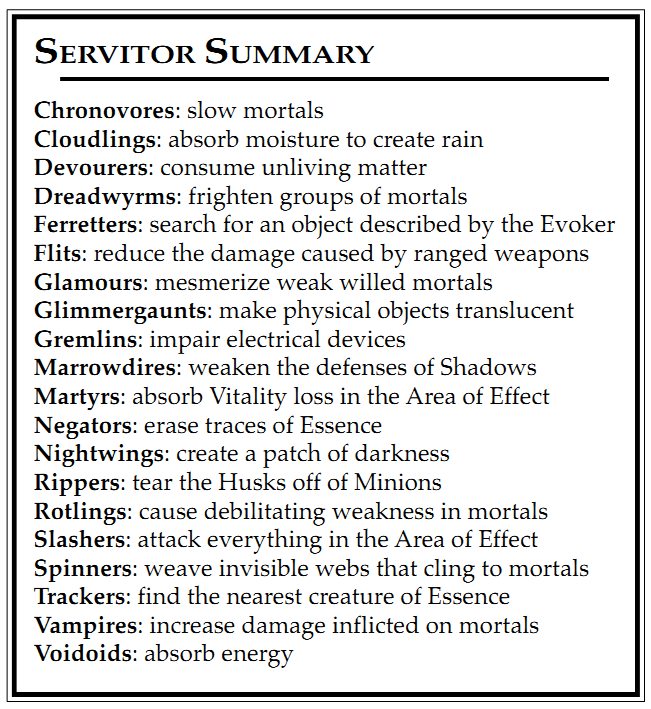
Next we talk about your Vessel. When you enter the Realm of Flesh the Weavers (wait, who?) create a Vessel by spinning matter over your Avatar. Your Vessel is your physical form and thus has only physical attributes: Dexterity, Fortitude and Strength. Unlike your Avatar's attributes your Vessels are malleable and are recreated every time you re-enter the Realm of Flesh and so you get to choose different stats every single time. You get 3 in each of the three Attributes and can add one point to any attribute of your choice for each point of Willpower that you have. Mortals max out at 5 on this scale, but there's no limitation mentioned for Stalkers.
The game straight out tells you that Strength is not actually very useful as it only determines the base damage of unarmed combat (apparently armed combat doesn't use strength?)

The four-armed PI is clearly a being of great enlightenment and refined Essence
Next we come to Skills, which are a little bit hinky in terms of how the points are divided:
First, you pick three Primary skills which get a +4 bonus.
Second, you pick a number of secondary Skills equal to your Insight. All of these have a +2 bonus.
You then get a number of points equal to your Insight to divide among primary, secondary or other skills, so long as no skill goes above +6.
Then we have "Focus Skills" which...I'm having trouble working out. First we're told that a Focus Skill is strongly related to a character's mortal past and should be very important to them. GMs may require all players have at least one Focus Skill and you can have up to three. I'll quote from the book here: "To buy a Focus Skill all you have to do is decide what it is called, write it on the character sheet and assign a bonus to it." So...does that mean that Focus skills can be purchased separately from your Primary, Secondary and other skills...or do you have to use those points and just declare that one of those skills is a Focus skill? And to be clear, Whispering Vault isn't a game where skills are normally player-derived like in Unknown Armies.
We're then told that some Focus Skills give a bonus when using a Discipline that requires a Challenge Roll. These skills have the same name as the associated Discipline so a Focus Skill to help a Stalker use Dominate is called Dominate. I thought a Focus Skill was supposed to relate to your past? Starting PCs may only have two of their potentially three Focus Skills related to a Discipline.
And that's all we're told about Skills, we aren't even given a brief list and the skills mentioned (Masking, Binding, Sensitivity, Mending) here and there are very vaguely named. So good luck in trying to understand where you should be putting those Attribute points.
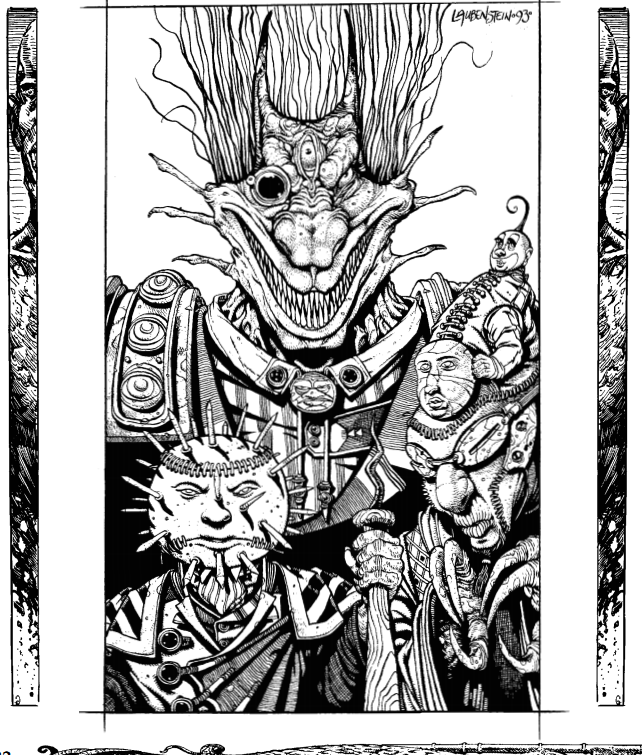
Baseball pin-head is my most enduring image of Whispering Vault
Next we go over your Five Keys of Humanity. The Keys are material objects even in the Realm of Essence and are the Stalker's gateway to return to the Realm of Flesh and so they're carried at all times. Everyone should decide what form their Keys take and while they're usually actual keys of some sort they can be just about anything symbolically important. They're always displayed prominently on the Avatar and Vessel.
The Keys are also your defining human aspects and there are three types: Virtues, Flaws and Memories. Virtues and Flaws are purely relative, its not important whether or not they're actually good or bad but whether or not you believe that they are good or bad. Memories are life-shaping events from your mortality, such as the loss of a loved one or an amazing accomplishment. Not every Key needs to be defined at character creation, only 2-3 and the rest can be worked out in game.
Although they are physical objects and thus could be taken the Stalker can summon them back at will, unless prevented by magical rituals. Being without your Keys is a big deal, you can't spend Karma (whatever that is), use Disciplines, summon Servitors or use Vitality for Strenuous Skills. You can't take any direct action against anyone holding one of your Keys and you will turn to dust and die in two days if the Key is not retrieved (the dust can be drunk, along with fresh blood, to grant a mortal longevity).
So yeah, don't lose your damn Keys. Fortunately, there don't actually seem to be any rules for how a Key would be taken from you given that they can be summoned instantly and as far as I can tell Stalkers don't sleep or otherwise get themselves into a situation where a Key could be stolen surreptitiously.

The last stage of character creation is some last-minute touches. First we've got your Vitality, when you are bound by Substance in the Realm of Flesh you are vulnerable and your Vitality will suffer as you take damage or use skills that drain your Essence. Hit points. It's your hit points. You get Vitality equal to twice your Willpower, something that should have been mentioned much earlier. Next we have Karma which is the meta-currency for re-rolls or to use Inspirations. You get 5 Karma and earn more with successful Hunts.
Oh, and your name, or names as the case may be. Stalkers tend to have flowery or evocative names: "The Gray Man", "Shadowjack", "Abrax", "Calaphon", etc.
With that we have completed chapter one. I've lost count of the Capitalized Words but I bet we're over 40 by now. I won't say Whispering Vault is a bad game, but damn it could use some work on clarity. Still, definitely points for style and imagination so far.
Next we get into the actual rules on playing the game and hopefully some things will become clearer.
Part 2
Original SA post
The Whispering Vault: Part 2
Been a couple of weeks so here's a quick summary of the first chapter:
You're former humans turned crazy cenobite-security guards whose job it is to ensure that the human realm doesn't get screwed up by perverted gods. Except with a lot more Capital Letters. Here's the link so you don't have to crawl back for a reminder: http://forums.somethingawful.com/sh...8#post459783153
Now we're on to the actual rules.

So, the game starts with rules for resolving basic challenges, called (appropriately) Challenge Rolls. Each Challenge is based on one of your Attributes and you roll a number of dice equal to the appropriate attribute. You keep only the highest roll or the sum of the highest matching dice. The difficulty of a Challenge is either based on a set target number:
Routine: 8
Easy: 10
Average: 12
Hard: 15
Very Hard: 18
Or it is based off another character's Attributes and then modified to reflect difficulty (from -4 for routine rolls to +5 for Very Hard rolls).
But attributes aren't all, there are also Skills. Skills don't adjust the number of dice you roll, instead they add directly to your roll result (so effectively they reduce the target number). You may also spend Karma on a roll, which allows you to reroll as many of the dice as you witch (to increase the odds of a match). Apparently the GM is allowed to forbid the use of Karma if it seems "frivolous" which seems unnecessarily restrictive.
So...you may have noticed something in the last example. I never mentioned the type of dice used in the game...that's because the rule section never actually tells you. That's right, its missing the actual central mechanic. Now, it is in the book, if you look at the "Welcome" page right after the table of contents (the page that most readers would skim or skip) you can find that the last segment on the page mentions that you'll need "a handful of six-sided dice", the fact that none of the example rolls ever go higher than a six is another clue...but it's still a massive and glaring omission in the rules.
So with the die-type revealed I can honestly say that I simply can't parse the probabilities for these rolls. A 12 as an "average" difficulty seems huge to me...but I actually don't know how you'd effectively calculate the odds of rolling a 12 on 5 dice. I'm sure someone else is more willing to crunch the numbers than I am but it's still maddeningly difficult to tell how good you are as a character. Of course, the difficulties are probably set with the assumption that you'll be using your Skills to reduce the target number.

Next we have combat.
First the game waxes on a bit about how "different" Whispering Vault is from other games:
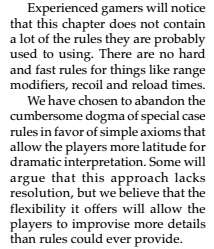
The next few pages go on a bit more about how you should be flexible when adjudicating specific actions or consequences of your rolls, the importance of descriptive language, etc. It's not bad advice as such but it seems to think the advice is far more original and groundbreaking than it actually is. Even in the early 90s things like "don't just say 'I hit it with my axe' wasn't exactly cutting edge of game conception. But, as I mention its still good advice and it helps set the theme of the game a bit.
Anyway, down to the actual rules.
At the start of each round in combat each character makes a Dexterity Challenge and the final total is used as your Initiative score. This only applies for PCs...NPCs have a set initiative score that they always use. I'm noticing that while the game never says it outright it seems like the intent is that NPCs generally don't roll anything (with one exception being a small section on NPC v NPC actions).
Actual actions in combat are divided between Significant Actions and Insignificant Actions. Significant Actions are things like making an attack or using a power and Insignificant Actions are things like moving around, talking or dropping something. You get to make one of each every round.
Players make all the rolls in combat. You make an appropriate Challenge with an opponent's defense attribute serving as the target number. The same goes if you are attacked, making an appropriate Challenge against an opponent's attack attribute.
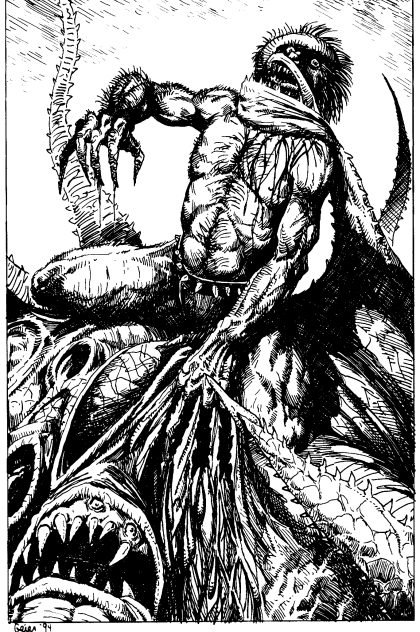
Damage is not a challenge (and its the only time the GM gets to roll). Your Damage is a collection of dice that get rolled. A Stalker's damage is either their Strength value or the Damage of whatever weapon they're using. It's confusion because they use the terms "Melee" and "Unarmed" as though they are interchangeable. But apparently weapons like swords don't actually benefit from your Strength bonus. Monsters have a Damage rating that indicates how much damage they inflict. All the dice you roll for damage are added up to determine the final damage.
There's also a special rule called a "Die Cap". It's an unusually complicated system that isn't actually very worthwhile considering it only applies to Mortals fighting beings of Essence so, as far as I can tell, it will never affect the Stalkers directly. It just means that Mortals are terrible at hurting Essence-based opponents, something that it seems could have been handled in a much simpler way. But apparently the Damage Cap doesn't apply to "Masked" Stalkers (something that hasn't been explained yet).
A Die Cap is a maximum amount of damage that the attacker can inflict, basically ignoring any results higher than your Damage Cap...which actually means it's possible for a really good roll to end up inflicting no damage at all because every result is above the Damage Cap.
The standard Damage Cap is 5. But if you are Demoralized and Terrified (both of these are capitalized, and it is not explained whether they're simply two terms for the same thing or if they actually have different effects) then your Damage Cap drops by one. If you are Inspired (such as by a strong leader or a personal motivation) then your Damage Cap increases by one. Fighting as a group also means your Damage Cap increases by one.
There is also the Law of Proximity, which actually does apply to Essence users, basically lowering Damage Cap by one for any ranged attacks made by or against a being of essence. Oh, and the other time a Die Cap affects a Stalker is when they attempt to use mortal weapons of any kind, causing them to suffer a -1 to their Die Cap...so picking up a mundane gun to shoot a mortal inflicts a -1 Die Cap (since you're attacking a mortal with a mortal weapon) but a -2 die cap if using it against another Essence being (since it's a mortal weapon and you still get hit by the Law Of Proximity).
So, in short, guns kind of suck unless you're using the absolutely highest powered guns which can unload double digits in the damage dice.
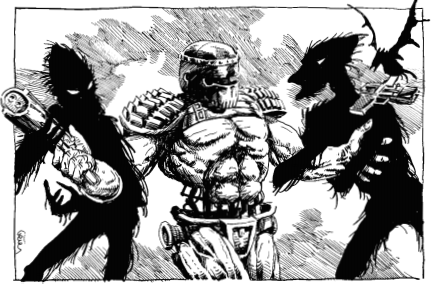
I'm already getting kind of annoyed with the Damage system here, but it gets even more complicated.
So, recall characters have two traits: Fortitude and Vitality. Fortitude is your damage resistance and you divide any damage you suffer by your Fortitude score, rounding down. So if you're hit with 30 Damage and have a Fortitude of 5 you lose 6 vitality.
The actual effect of damage depends on the type of victim you're attacking:
Shadows: An Awakened Shadow can manifest in the Realm of Flesh. If their Vitality is reduced to zero they are forced back into the Rift. It also notes that Shadows that have been Awakened by the Unbidden to serve as Minions are encased in shells of Flesh (not the shells of Flesh shadows normally use, these are other shells) called Husks which let them kind of pass as Human (yes, Human is capitalized) to enjoy the protection of the Veil (we don't know what that is) and the first time such a Minion takes damage the Husk is destroyed revealing the Shadows true (well, not true, but not human) form. Once a Shadow's physical form has been destroyed a being of Essence could choose to continue fighting them (and apparently formless Shadows can continue fighting back) but any attacks made by or against Formless Shadows suffers a -1 Die Cap.
Mortals: I'm not sure why this section is more than "Mortals are defeated when their Vitality is reduced to 0" but we're also filled in on how damage overflows for a mortal (extra damage reduces Fortitude and when Fortitude is at 0 the Mortal dies) and how many weeks it takes for them to heal.
The Unbidden: The Unbidden steal the body of human (not capitalized this time) Hosts in order to serve as Vessels, strengthening the Host's Flesh with their Essence. Despite being in a mortal body it is not clarified if this form is treated as mortal or not for purposes of Damage Caps. When the Host runs out of Vitality the Unbidden is forced to manifest its true form (despite being a being of Essence its true form is apparently a physical body?). In its true form the Unbidden can be Bound (we don't know what this is) otherwise it may attempt to find a new Vessel and until it does it cannot recover Vitality and is not protected by the Veil (we still don't know what this is) and it is vulnerable to Forbiddance (we also don't know what this is). When the Avatar (I guess this is the true form?) of the Unbidden loses its vitality it is helpless and can be bound. Actually killing the Unbidden is possible but is blasphemous.
Stalkers: When a Stalker runs out of Vitality they begin to lose points from their Vessel's Attributes. You get to decide which Attributes are reduced and how much damage to apply to each one. Losing all Strength or Dexterity means you cannot move, losing all your Fortitude means you die. You heal automatically if you go back to the Realm of Essence (since your body is just a construct) but its only possible to heal in the Realm of Flesh if you have the Weaving Discipline.

Finally, we have weapons. A short table is provided with example weapon damage, but it points out fairly directly that using a weapon as a Stalker is kind of a bad deal, you suffer not only a -1 Die Cap but a -2 penalty to actually using any weapons (without an appropriate focus skill). Despite this the ability to simply ignore your Strength and just go with a weapon's damage die is going to be tempting depending on the quantity of weaponry available.

And that's it for the "rules" chapter. Although some of the ideas are interesting, I've got to say that the combat rules are way too elaborate, especially in comparison to the one page rule for handling everything that isn't combat.
Part 3
Original SA post
The Whispering Vault: Part 3
Disciplines
Now we come to Disciplines. Disciplines are Whispering Vault's collection of advantages...some are more like simple feats or edges from other games, some are more like supernatural powers. They're one of the big ways you customize a character to a different role, because while you can change your Vessel's physical stats from Hunt to Hunt, your Disciplines remain fixed and a lot of them are nigh indispensable for some character builds. This is especially true of combat, since Stalkers apparently stink when it comes to using human weapons you're going to want the appropriate Disciplines to supplement your strength or give you a ranged attack when needed.
The game really plays up the nature of Disciplines, stating that they are insights into the true nature of the universe and allow the Stalkers to manipulate the Dream themselves in order to alter reality. Some of the Discplines live up to this hype, most don't. Before getting into the Disciplines themselves there are two rules the book brings up:
Strenuous Use Some Disciplines take such a large amount of Essence that they will weaken your Vessel, costing Vitality. This is meant to be only the most powerful Disciplines.
Mastery: At the cost of an extra Discipline "slot" you can Master one of your Disciplines to be extra awesome with it. This not only increases your bonus from the Discipline but gives you access to something called Inspirations. The idea behind Inspirations is that they're meant to be improvisational uses of your Disciplines to accomplish something that isn't normally a part of the Discipline. However, there are no guidelines provided on Inspirations with a single exception (attacks with Inspirations inflict Damage equal to your Willpower attribute). That's it. The sole example provided of an Inspiration in action is basically just a more limited version of that: using Terrify to "attack" a mortal by scaring them to death, an attack that inflicts your Willpower in damage and has no effect at all if it doesn't kill the target.
Using an Inspiration costs Karma, the standard amount is 1 Karma but its noted that the cost can increase for exceptional uses of the Discipline (the one above apparently merits a 2 Karma cost).
This kind of highlights part of the problem that Whispering Vault has: there are almost no rules outside of Combat...essentially they boil down to [Roll an Attribute Vs a Target Number] (with no guidelines for setting a Target Number beyond words like "easy, hard, routine, etc). This might fly in a rules light game like PDQ but Whispering Vault really doesn't qualify.
There's also some of the standard mid-90s GMing advice where you show the players who's in charge:
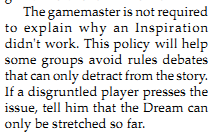

So, lets get down to the Disciplines:
Conjure: Creates a small object (small is not defined) which is normally permanent. The difficulty of the task (an Insight Challenge) is based on the complexity of the object. If you're a Master you can create several small objects at once or a single large object (which is defined as "no bigger than you can carry") which will slowly disintegrate over several hours. Despite being created magically there's no ruling on whether or not weapons created this way count as "mortal" or not for penalties like your Die-Cap. If it weren't for the frustrating ambiguity over how big a "small" object is this would probably be one of the most useful non-combat powers. The power has a lot of blind spots as well for things like grenades and c4.
Delve: You can read minds. This requires physical contact and an Insight Challenge and it states that it yields "ambiguous" results, which is appropriately a very ambiguous rule. In fact I think I may have to cut myself off from using the word "ambigous" anymore because otherwise this chapter will force me to type it every paragraph at this rate. Even more ridiculous is that if you find a traumatic memory you have to make a Willpower challenge or lose "one or more" points of Vitality. That seems kind of BS doesn't it? I mean, Stalkers are supposed to be the protectors of the universe who are sent to hunt down naughty gods and they're going to fall to pieces because of something that scared a mortal? If you Master Delve you can also use it to speak with the dead, with penalties for badly decayed or destroyed corpses.
Disintegrate You can destroy "small" (there's that word again) objects with a touch. If you've got plenty of time you can just do it but doing it quickly takes a Willpower challenge, based on the durability of the object. Disintegrate "cannot be used as an attack form under any circumstances" which seems to cut out a lot of possible Inspirations. Masters can disintegrate any object they can see and can even destroy larger objects like doors or cars in exchange for a Vitality point. Frankly unless you are a Master I see no point in taking Disintegrate...most Stalkers are more than capable of breaking objects if the need arises.
Dissipate: Definitely one of the most useful Disciplines, Dissipate lets you pass through objects or barriers. If you do it slowly there's no roll needed but a quick phase requires a Willpower roll and a failure costs you a point of vitality. The Master version lets you take a person or "large object" (if you're going to keep using these terms then fucking define them! We've had "large object" refer to anything from the size of a sack of potatoes to a car in contradictory ways) with you but this makes the process take so long its practically pointless: up to a minute or more to walk through a wall.
Dominate: Your mind controlling power. This is a Presence challenge and most mortals will do whatever you want so long as you want them to (makes Delve look kind of shitty since this means you can just force mortals to tell you what they want to know and it doesn't require touch or risk damage from bad memories). If a mortal is Driven they can shake off Domination "a matter of rounds". If you fail to Dominate someone you can't try again. A Master in Dominate can attempt to control a Minion but this requires you to overcome the Resolve of the Unbidden controlling them, which is probably around 20 or so, and costs a point of vitality. Keeping control also uses up your action every round.

Foresight: I haven't even started reading this entry yet and I bet it'll be ambi...unclear. Foresight is Strenous, costing a point of vitality and requires a Challenge whose difficulty is the duration (in minutes) and granting a +1 bonus to all rolls for that duration. However, if you fail then challenge then you have lost track of "now" and the GM decides how long it will take you to return. That's....really really shitty. A point of Vitality (keep in mind that most Stalkers have around 8-10 Vitality and can't heal) for a chance to get a modest bonus for a short duration and if you fail you're stunned until the GM decides you aren't. What if you master it? You can recall some of your visions "usually dreamlike cryptic clues that may help the Stalker complete their Hunt but never give them a direct answer". Son of a bitch.
Frenzy: And here we break the combat system with the multi-attack power. It lets you take two attacks (presumably only attacks, it doesn't mention other multi-action attempts) in a round in exchange for a -1 penalty to Strength and Dexterity for those actions. If you've mastered it you can up it further to 3 attacks in exchange for a -2 to Strength and Dexterity. The text suggests combining this with Savage (which boosts melee damage) but it is much better with the Rend power or a weapon since those won't be penalized by a strength reduction. With Frenzy and Rend you can pretty much set your Strength score to 1 on all your Vessels and pump up your Dex and Fortitude and just blaze away.
Morph Half the description for Morph seems to be missing. It states that you spend 3 minutes reweaving your vessel with an insight challenge but if you fail there's a cost of a point of vitality. It doesn't tell you what you can change yourself to look like but it does mention you can't mimic specific forms and can "come close enough to invoke the Veil so they can pass as a wolf or a tiger, but their Vessel would be monstrous". Honestly, I'm not sure exactly what this power lets you do...can I look like an ordinary dog, or is it going to be a silent-hill esque half-dog? Can I look like a human. What good is it if I can't change quickly, look unobtrusive or imitate someone? It also notes that no matter what changes you make there are no mechanical benefits (so growing claws won't help damage and wings won't let you fly). A master can at least change shape quickly and assume a human form (this is the first time not being able to look human has been mentioned) but still can't mimic a particular person which seems like a rip-off. Inspirations are mentioned to allow you to do things like develop venom or flight or armor (none of which there are rules for).
Rend This lets you make a ranged attack with Damage equal to your Willpower, but you're still penalized by the law of Proximity so it has a die-cap of 5. The attack must suit the Avatar's theme and automatically unMasks you, stripping away the Veil. A master adds +2 damage and may imitate a mundane attack form like a gun or a thrown weapon and won't be unmasked. A Master of both Rend and Frenzy is pretty much a combat monster.

Calm yourself citizen! I'm here to help!
Savage This gives you a +2 bonus to damage when using your Strength. Since this relies on weapons that are a part of your Avatar (claws, razor fingers, prehensile drill penis, etc) using it causes you to become unMasked. The mastered version increases the bonus to +3 and lets you imitate a non-supernatural attack and remain masked, making this much worse than Rend already.
Terrify: A Presence challenge lets you turn mortals into gibbering wrecks from fear, unless they are Inspired or Driven which makes them "hesitate" for a few rounds. No clue what that means. Of course, most any Stalker should be able to do this already by just showing off their true form and the Dominate Discipline is just as difficult and lets you take complete control over mortals. It has no apparent effect on non-mortals. If you've Mastered Terrify then you can use it against a group of mortals but the TN is the highest resolve +1 per mortal...making it kind of suck. It also won't work on a group led by someone Inspired or Driven and no we still don't know what those words mean yet.
Translocate: I've noticed that quite a few Disciplines are really just shittier versions of other Disciplines: Savage is a shittier Rend, Terrify or Delve are shittier versions of Dominate. Dissipate is the shittier version of Translocate. This lets you teleport instantaneously anywhere you can see without a roll. If you can't see the destination then you must make an Awareness challenge (notably unlike Dissipate you don't take damage for failing). Master Translocation lets you take a "large object" or another character but requires 3 rounds of preparation (still faster than dissipation) and a roll which inflicts a point of Vitality damage if you fail.
Ward: This lets you try and resist an attack from a mortal. Big problem here: no rules are provided for how it interacts with a normal defense roll...do you roll your defense normally and then roll Ward if that doesn't work? Does Ward replace your normal defense? Anyway, its a Willpower Challenge against a difficulty equal to the Damage...does that mean the damage dice of the attack or the actual rolled damage that's compared to your Fortitude because if its damage dice then Ward is pretty easy (since most attacks max out around 8-10 damage dice excepting the Unbidden or heavy weaponry) but if its against the rolled total then Ward is practically impossible (since that's usually 20+ when resisting a solid attack). If you succeed then you take no damage...fail and you not only suffer the normal damage but you take an extra point of Vitality damage. Yay!! Oh, and Ward uses up an insignificant action so that means you can't use it if you've moved or talked already that round and you can only do it once per round. Masters do not lose extra vitality for failing and you can try and Ward an attack from a Shadow or the Unbidden (i.e. the people you'll usually be fighting).
Weave: The healing power...which is a big deal since you can't heal normally on a hunt and only get a handful of vitality but also a big problem because Weaving kind of blows. It takes a number of minutes equal to the Vitality you want to recover and reduces your Willpower by one every time you do it (which lasts until the end of the Hunt). This not only reduces your maximum Vitality by 2 but it also reduces one of your attributes by one until the Willpower is recovered. Master Weavers can heal faster and can heal other characters...but this costs both you and the person you're healing 1 Willpower.
Whisper: Also apparently called a "silent scream". Whisper is one-way telepathy which works over any distance between Stalkers but only within visual contact when sending to anyone else. Masters can do two-way communication at any range but this requires a Presence challenge.
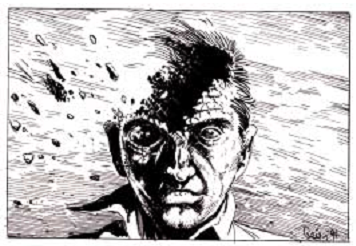
and that's it for Disciplines. Next we'll be talking about Servitors, your twisted grotesque pokemon.
Part 4
Original SA post
The Whispering Vault: Part 4
Servitors
Servitors are pokemon written by Clive Barker. Unlike Shadows they don't fully manifest in the Realm of Flesh and so they're invisible to anyone except for Sensitives and beings of Essence. They have singular roles so they're less like summoned monsters and more like spells.
Summoning a Servitor is a Strenous action so attempting it costs a point of precious Vitality and the difficulty is non-trivial. There are vague guidelines: it's Easy to summon a Servitor if you can take as much time as you want and are free of distractions and it's Very Hard to summon one in a single combat round in the middle of a fight, taking two rounds reduces it to merely Hard. If you've Mastered a particular servitor you only pay the Vitality cost on a failed roll. Considering the very small Vitality pool characters have and the difficulty of summoning a Servitor it's pretty much only useful if you Master them.
The book states that one of the advantages of Servitors is that they have nearly unlimited area and duration, limited only by the Forbiddance. Of course, we have no idea what the Forbiddance is so that's not particularly helpful.
So, with that in mind, lets get to the servitors:

Chronovores: These are capable of "loosening the grip of the Chronosphere" on Mortals and Minions. Basically its a slow spell, which reduces the attack attribute by 1, Defend by 2 and Initiative by 3. Not bad...except that you've got to sacrifice your action, spend a point of Karma or an extra point of vitality each round. If this worked on Shadows or the Unbidden that might be worthwhile, but since it only affects Mortals it's a hefty cost.
Cloudlings: Make it rain!!

This is the stupidest Servitor by far. They absorb moisture from the air and rise up to release it as rain 10-20 minutes after they're summoned. That's all. Oh, and you can dismiss them before they "burst" in order to simply leave the air dry. I suppose that secondary option might be useful for clearing some fog...but honestly I can't imagine they're very useful. This isn't a setting where rain or running water has any special properties...this just produces a moderate rainstorm with a 10-20 minute head start.
Devourers: This servitor is fairly interesting and actually fairly useful (it certainly makes the Disintegrate discipline look like a chump). Devourers will consume matter, up to several tons of inanimate matter, regardless of the durability of the substance. However, barriers or objects that have been enchanted cannot be harmed and the Devourers are forbidden from consuming living flesh and the taste of fresh blood will immediately banish them. See, that's an interesting servitor, it's got flexible utility and enough weirdness to make it more than just a re-skinned disintegrate power. I wonder if any of the rest will live up to this.
Dreadwyrms The servitor version of the Terrify power, less intense but broader and harder to resist...but at the cost of Vitality. It causes any Mortals who hear the Dreadwyrms telephathic whispers to become Terrified (lowering their Die Cap), unless they are Driven or Inspired. It can also cause a panic, but no rules are provided for when this happens, just saying that it might happen. Panicked mortals lash out violently and get +2 to attack but -3 to defense, fleeing immediately if injured.
Ferretters: By describing something you are looking for the Ferretters will find it. They can fly and go through walls, moving 10 times faster than a human. They'll continue searching for whatever time you ask them to and return to you when they find it. They're too dumb for abstract orders however, so you can't tell them to "find Shadows" or "find the Unbidden".
Flits: This is a "shield" effect where the Flits apparently bodily hurl themselves into the path of fast-moving objects. Reduces ranged damage by 1 die, 2 die for high-velocity projectiles like guns. This only affects melee attacks if you are using Frenzy, which also inflicts a -2 penalty. Not particularly impressive.
Glamours: This one beats Cloudlings for the record of "stupidest Servitor". Glamours produce light-shows that can only be seen by Sensitives...so it doesn't affect normal mortals and it won't affect Shadows or the Unbidden... just Sensitive Mortals. Furthermore, only Sensitives with a Perception of 12 or higher and a Resolve of 13 or lower. That's an incredibly narrow class. All the lights do is reduce Initiative and Perceive by 2 while its going on...except there's also a 1-in-6 chance that minions will become enraged by the lights, granting a +1 bonus to attack! And like all servitors this costs a point of Vitality to accomplish.
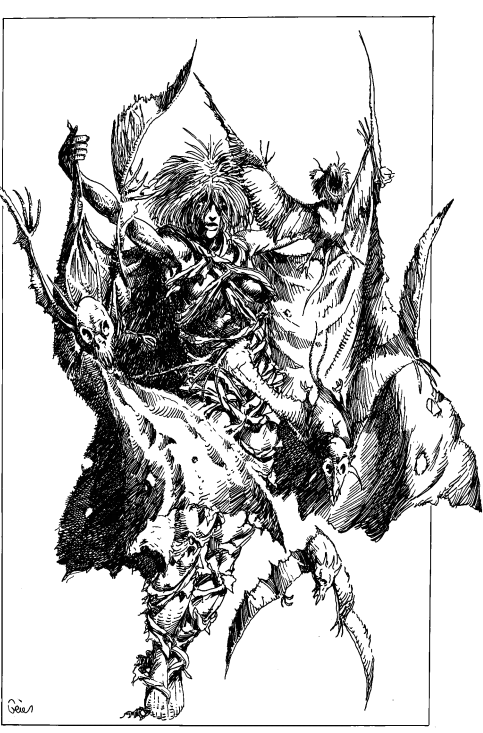
Lets comfort ourselves with this cool looking image
Glimmergaunts: The glimmergaunts produce an ethereal light visible only to beings of Essence and Sensitives with a perception of 15 or higher (by the way there are no example Sensitives in the book, so it's not clear what their stats "normally" look like). This makes physical objects transparent, allowing you to see through them. There's no limit to the depth you can set it to but it can obviously get hard to interpret stuff past a certain point. The light is also disturbing to other Servitors, driving them away unless the summoner spends a point of Karma.
Gremlins: you can probably guess what these do. It only works on high-tech equipment, which may be an issue considering the Stalkers cover the entire time-stream, but given their utility any time after 1900 it's probably still worth someone getting them. Theoretically it should shut down all such devices in the area of effect...but then it says "there is always a chance a device that should be affected will work properly". Of course, no rules are provided for what that chance actually is...it's just up to the GM whether or not some important item is still working or not.
Marrowdires: Wow, really stretching on the name for this one. These are parasites that feed on the Vessels of Stalkers, Shadows and Unbidden. Anyone in the area of effect (including Stalkers, so be careful) has their Fortitude reduced by 1. However, an attack that inflicts damage will drive out the parasites, resetting the Fortitude until the start of the next round (assuming you don't escape the area).
Martyrs: These servitors sacrifice themselves to prevent others from feeling pain. That's sweet. It reduces all damage in the area by 1 Vitality and the cloud of Martyrs can absorb up to 9 vitality before they're all killed. Pretty effective if used wisely.
Negators: These creatures eat up Essence in the area. This prevents a Sensitive from "reading" an area and blocks most form of mortal magic which requires access to this essence.
Nightwings: The nightwings block out light in the area, causing anything from a dimming to pitch blackness as you wish. However, "they may linger longer than their master desires". There are no rules for what that means. I should point out that there also aren't any form of standardized "situational" modifiers so there's no actual guidelines on what penalties or bonuses darkness would provide.
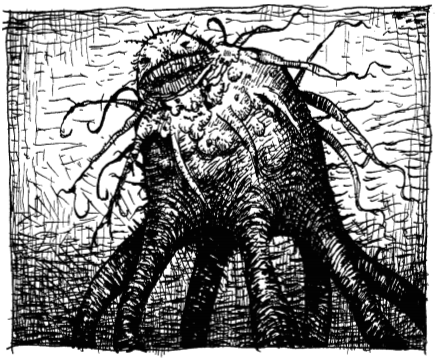
Rippers: These creatures rip off skin, the little darlings. This de-husks Minions and inflicts 1 point of Vitality damage to mortals with Fortitudes of 1-2 or lower. The Unbidden can take control of these servants, turning them into a 6-die attack against the summoner. Considering that they're not very impressive to begin with, that's a pretty hefty penalty.
Rotlings: 1-6 rounds after exposure mortals in the area fall ill if their Fortitude is less than 4. The illness drops attack, defense, strength and initiative by 1. Exposure can be fatal to sickly victims but otherwise it'll run its course in an hour. however, the disease can be transmissable to others, meaning a mini-plague can start.
Slashers: A big area of effect attack from spinning little monsters, they are treated as a 4dice attack against everyone with a die-cap of 5 against shadows and 4 against stalkers and the unbidden. They also won't attack anyone already wounded.
Spinners: These guys spin invisible webs that can only be seen by Sensitives. The webs have no effect on beings of Essence but cling to mortals (including the Husks of Minions) and "slowing them to a crawl". Unfortunately no actual rules are provided for what this means. Can they defend themselves? Can they attack? What about objects like mortal weapons? either way the webs apparently dissolve in an hour or when cut by a "living knife" or the sound of churchbells. These weird little conditions you see on some Servitors are interesting and hint at an interesting setting but since its so scattershot whether or not a particular servitor has a limitation like this then it ends up being too forgettable.
Trackers: A more limited version of Ferretters. Trackers also run through walls and will find the nearest creature of Essence and then howl just loud enough to reach the summoner. Mortals cannot hear the howl but sensitives and beings of Essence can...so it's not terribly helpful when pursuing prey to alert them to the fact that you just found them.
Vampires: The reverse of Martyrs. Vampires will seek out the wounds of Mortals or the Host of an Unbidden and drink from the wounds, increasing vitality damage by 1. Once they get 9 points of vitality they're sated and leave. If they are not sated within 3 rounds they will start to feed on Stalkers as well (but apparently not Shadows or the Unbidden's Avatar).
Voidoids: Winner of the "stupidest name". They resemble floating jellyfish with eyeballs on their tentacles. They can mute, but not neutralize just about any sort of energy. This lets them do things like reduce fires, interfere with radio signals, dim lights etc. Definitely an interesting ability, hampered by the fact that there are no guidelines for doing things like reducing damage from energy sources or actual guidelines for how much you can reduce a signal.

So, servitors are more interesting than Disciplines but the Vitality cost renders them pretty-much a non-starter unless you're a Master and many of them are just flat-out not worth the effort.
Next we'll be looking at Skills!
Part 5
Original SA post
The Whispering Vault: Part 5
Skills
Skills, in case you've forgotten, work as a bonus to your final roll. Given that even the lowest difficulty rank requires multiple matching dice to achieve without a bonus, skills are pretty damn important. I'm still not very good at figuring out the probabilities behind Whispering Vault's dice but from what I can tell it's going to be damn hard to succeed at much above an "easy" roll without a Skill bonus of some kind. In fact, your skill bonus has a much more dramatic effect on your odds of success than your attribute.

As a break from the otherwise high quality WV art, here's a skull with a "twirl" filter
First, let's talk about Focus Skills, this was something very vaguely defined back in character creation but it's given better definition here. Focus Skills are player-created skills that are usually meant to represent elements of your human life that are still a part of you (except when they don't). Sadly, they're better defined but not much better. The impression I get is that they're meant to be "professional" skills that you've carried over, things like "Doctor" or "Hacker" or "Homicide Detective" and so on.
However, only one example is provided of a Focus skill: Sniper, which the game mentions is redundant compared to the basic Attack skill and so it suggests providing a +3 bonus when firing small arms (small arms? since when do snipers use small arms?) from a concealed location. It seems like anyone should really get a bonus under those circumstances but I guess I see the intent.
One significant benefit of Focus Skills isn't actually mentioned here but is found back in the combat chapter: an appropriate Focus Skill lets you ignore the -2 die penalty for using a mortal weapon. You still suffer a die-cap penalty but considering the fact that using a weapon lets you ignore your strength and obviates the need for the Rend power to make ranged attacks it's definitely worthwhile for the right character. My first thought was a character with a Focus Skill like "Soldier" and the Conjuration discipline walking around with a machine gun and a vest-full of grenades and putting everyone else to shame.
In the character creation section it is also mentioned that Focus Skills could be used as "Discipline Skills" but this is not mentioned here at all. Which is unfortunate, because as I mentioned it's extremely difficult to pull off any unskilled rolls.
Anyway, onto the normal skills:

Attack: Guess what this does. This covers every single attack method and you are in the "hunting-evil-gods" line of work so there's literally no reason for every character not to crank this up as high as possible, unless they're using a Focus Skill instead. Otherwise every character pretty much needs to take this as a primary skill, especially because literally no sample character (including "ordinary joe" mortals) has a Defend score below a 10.
Banish: This lets you banish awakened Shadows back into the Rift. The basic method is a Presence-vs-Resolve Challenge (plus skill bonus) but with vaguely defined modifiers...banishing a "wounded or outnumbered" Shadow is Easy (i.e. a -2 to their Resolve) but banishing a "healthy creature encountered in its lair is much harder". If you are using this against a Minion (as opposed to a "wild" shadow) the difficulty is against the Unbidden master's Resolve, modified by the creature's proximity to its master. No it doesn't tell you how the thing's proximity modifies the difficulty. Each banishing costs a point of vitality, making it a very poor choice compared to just killing the thing.
Bind : The Unbidden apparently have to be Bound before stalkers can pass judgement, of course we don't know what this means yet. But first you've got to destroy the Unbidden's Vessel so you can Bind its Avatar. This is a Presence-vs-Resolve roll "modified by morale" (no, it doesn't tell us anything more than that). If successful this creates a Radiant Orb to contain the Unbidden. Here's the real bitch...Binding is only used to trap the Unbidden in a pokeball and it's a strenuous action taking a point of vitality to even attempt. Since the Unbidden have massive Resolve scores you pretty much have to have a single character who has maxed out Binding and hoards all their Karma until the very end of an encounter with the Unbidden to keep trying to Bind them. If your "designated Binder" gets KO'd (or just fails too many Binding attempts) then your Hunt is literally unwinnable....because this is the only way to get an Unbidden back to the Realm of Essence.
Charm: About as self-explanatory as "Attack". This skill covers all pleasant interactions with Mortals.
Deduction: This is a skill that starts off seeming self-explanatory but gets maddeningly vague. The assumption would be that this is your general "figure things out" skill (basically replacing the otherwise standard "intelligence check") but the text seems to imply that it serves a more mystical role of understanding the alien minds of the Unbidden. Not really clear.
Defend: The opposite of Attack and possibly more important. Since everyone has such a small pool of Vitality it's essential that everyone have a good Defend score. It's kind of hard to justify not taking Attack and Defend as both Primary skills since every single storyline is going to end in a throw-down with a shoggoth. Even if you aren't going to be involved in combat (say the team's designated Binder) defend is so essential because otherwise it only takes a few lucky shots to take you down. Stalkers aren't nearly as tough as they seem to think they are.
Evoke This is the skill for summoning a Servitor.

History: In most games this would be kind of a throwaway knowledge skill, but in Whispering Vault it's somewhat essential since games involve jaunting around to different times and places like a lovecraftian doctor who.
Intimidate: Charm's flip-side, when you want to spook or freak out mortals without using the Terrify discipline.
Mask: This conceals your true features and the use of supernatural powers "when the Veil fails to do so" (no we still don't know what the Veil is). What requires Masking is pretty vague, it says Masking the Whispers discipline is an example of something Easy...but why should you have to? Whispers is a telepathic message, the entire point of the Discipline is that you can send a message without being seen or heard to do so...but apparently we've got to make a Masking roll or...what? what happens if you fail to Mask whispers? It then goes on to say Masking something like Translocation is Hard...how would you Mask straight-up teleportation? Is this a UA style "everyone just happened to blink and when they opened their eyes you were gone" or does it create an actual illusion? Also apparently Masking is done against all observers, if you're being seen by more than one person at once then you've got to make two rolls at a +2 penalty (well, I assume its a penalty...it says "+2 modifier" which could mean a penalty of +2 to the difficulty level or a bonus of +2 to your skill) and if either roll fails then at least some of the observers have seen you.
Mending: Another highly specialized but absolutely essential skill like Binding. You see, when an Aesthetic abandons its post it creates a wound in the world called an Enigma which can be healed if you can find the Focus of the Corruption (If I've got to deal with all this jargon so do you). This is an Awareness vs Resolve (the resolve of the Unbidden) roll and costs a point of vitality...and if you fail trying again costs double the vitality and takes hours. A third attempt is impossible by the same character....and yes you have to mend Enigmas to successfully complete a Hunt. Basically every party has to have a single character with maxed out fortitude, Defend, Binding and Mending skills who does absolutely nothing of any interest and is just there to tote around so they can patch things up while the other characters actually do shit.
Occultism: This lets you recognize the use of magic (or its signs) when you see it, mortal magic specifically, not Disciplines or the like. Kind of useless.
Perception: You can guess what this does I'm sure.
Sensitivity: This lets you detect traces of supernatural crap. It's not really very helpful as it is active only, requires you to sacrifice a point of vitality and only provides a confirmation that yes, something spooky happened and how spooky it was on a scale of 1-3. It explicitly cannot be used to track the Unseen forces to their source or even identify if the particular spooky shit you detect is the the sort of spooky shit you're looking for.
Stealth: Again, pretty self-explanatory.

And that's the Skills section. Pretty bland for the most part other than some vague-as-hell skill descriptions here and there and the continued insistence that it's a great idea to use your Vitality as a source of "MP" when you're likely to have only about 10 vitality points and no source of good healing.
Next is "The Hunt" where we actually start explaining all the Capitalized Jargon Bullshit that litters the book.
Part 6
Original SA post
The Whispering Vault
Part 6: The Hunt
Now we are finally done with the various elements of creating a character we get to the "meat" of the game: The Hunt.
This is both the most interesting and most damning chapter in the book. It's interesting because we actually get some payoff on all the vague allusions and references throughout the book and some idea of what you'll actually be doing in play...but the problem is that it makes it clear that The Whispering Vault is intended to be incredibly formulaic and a lot of the cool, inhuman cosmic-cop stuff is going to be a bit one-sided.

To quote the chapter's first sentence: "Every Hunt follows the same basic framework." and boy is this true.
These are the steps in a Hunt:
1) The Stalkers receive a Call for help from a mortal Supplicant who is endangered by an Enigma. The Called stalker calls the rest of their Circle (i.e. the other PCs) to their Domain.
2)The Stalkers are transported to the Realm of Flesh by the Navigators, taking them to the Winding Path.
3) Halfway along the Path a Barrier will bar your way, maintained by a Guardian who must be Dismissed before the Rift can be crossed.
4) Upon arriving on the threshold on the Realm of Flesh the Stalkers must call upon the Weavers who cover their Essence in Flesh to cover the Stalker's Avatar.
5) Disguised as mortals the Circle must find the Renegade. The Veil of ignorance and the Mask of humanity protect the Stalker from the Forbiddance (we still don't know what this is).
6) The first step is to find the Enigma and Mend it.
7) Find the Unbidden, who must take over a human Host since they cannot use the Weavers to take a mortal form.
8) You must defeat the Unbidden's Minions and Bind it.
9) Summon the Navigator again to return to the Realm of Essence and stick the Unbidden into the Whispering Vault.
So...yeah. I won't say these things aren't necessarily interesting but you'll notice two things...first that's a lot of repeated steps that are going to get significantly less interesting the more it happens. The interesting part is certainly going to be step 7 and 8, the actual "hunt" part of the Hunt...everything else is relatively dull and is going to remain unchanged from one Hunt to the next. The second thing is that everything happens on the way to or in the Realm of Flesh...there's nothing at all other than the Hunt in this game...there's no interaction between Stalkers and other beings of Essence. There is nothing to do during your downtime at all. You're just cosmic firemen playing poker until another alarm goes off.
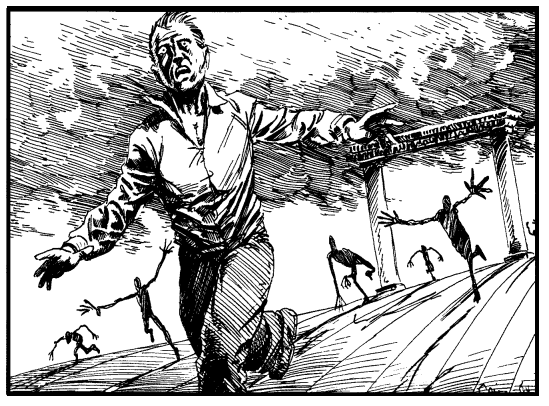
Receiving The Call
There are a few of what I like to call "Big Dumb Rules" in the Whispering Vault's cosmology. Stuff that gets handed down by the Primal Powers for no apparent reason other than to make things hard on the Stalkers. Probably for ineffable reasons.
The first Big Dumb Rule is that apparently there is to be no watching over the mortal world for the invasion of the Unbidden. The only way a Stalker can travel to the Realm of Flesh is if they are Called by a mortal who needs their help, the Supplicant. In fact this is apparently the only way anyone in the Realm of Essence is going to be aware of the intrusion of the Unbidden. Fortunately, the Supplicant doesn't have to know what the hell is going on...they just need to meet two requirements: first they must be endangered by an Enigma (apparently only the Enigma...tough luck if your face is being eaten by a Shadow or your guts being unwound by one of the Unbidden) and they must be appealing to some higher or otherworldly power for help.
There are apparently exceptions when the Primal Powers intervene directly (no information is provided on this) or when a mortal uses a special Ritual to summon a Stalker (although this provides no power over them). There's an over-half-a-page sidebar on how each player should come up with a few rituals that might be known to mortals to summon them...but its not clear why this would be at all important since it also makes it clear that any mortal endangered by an Enigma can perform a Calling without any actual frippery.
The GM should pick (more or less randomly) which Stalker gets the Call. The Stalker will be able to use the Call to guide the Navigator to reach the Supplicant (who is usually Sensitive but not necessarily Enlightened). Stalkers will usually appear directly when Called by Enlightened Supplicants but somewhere nearby when Called by the Unenlightened.
Oh, and you can't take direct action against your Supplicant as this is a direct violation of the Forbiddance, whatever that is but beyond that you aren't required to take any orders from them.
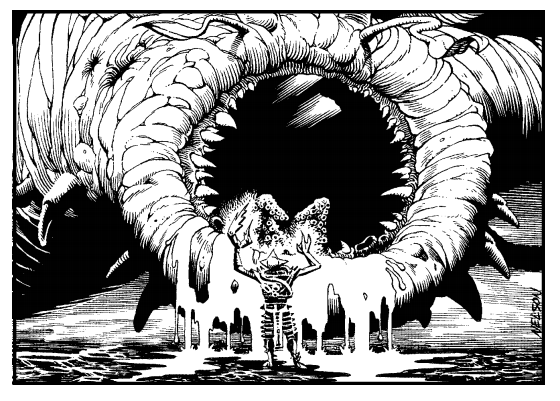
Calling The Navigator
Navigators are a type of Shadow used to bridge Flesh and Essence and they have the ability to trace a Call back to its source in time and space. All Stalkers know the ritual needed to summon a Navigator and it does not require a roll or any vitality. The only big downside is that in the Realm of Flesh the ritual takes about 3 minutes and the Navigator takes about an hour to arrive, so better make sure you summon it only after every danger has passed. The upside (given that their 90-foot-wide worms with infinite bodies) is that they never manifest physically in the Realm of Flesh and therefore it is invisible to anyone not Sensitive.
The Navigator eats the stalker and within will be a path stretching off into the distance, the Winding Path. So long as Stalkers follow the Path they will reach the Realm of Flesh but if they stray they'll be lost forever in the Neitherspace between Realms.
Then we've got a random aside on the Navigator life-cycle. You see apparently there are young Navigators which are more bestial and and simple-minded but as they age they develop personality and intelligence. These "Old Ones" develop the ability to manifest a Guide inside of themselves to accompany the Stalkers as they walk the Winding Path. Despite the name there's no actual guiding going on as there's only one Path and no chance of getting lost. The Guide is mainly an NPC to interact with, presumably to make this otherwise dull section of the Hunt more interesting. Even older Navigators can manifest Guides in the Realm of Flesh (invisible to all but Sensitives). These Guides "eventually" gain the ability to possess humans which is the sole useful function of a Guide...as Navigators are given no stats or abilities beyond this there is literally no purpose to a Guide unless they can manifest in the world of flesh where they will then invalidate a lot of Disciplines and Servitors by acting as invisible (presumably intangible) scouts and capable of controlling (with no apparent chance of resistance) a mortal.
However, there's a downside to using an Old One as your Navigator, as parasitic beings start to develop in these ancient beings and might pose a threat to Stalkers walking within them...except that they can't because there are literally no rules for any sort of conflict outside of the Realm of Flesh, Stalkers don't even have bodies yet at this point and thus no vitality, strength/dex/vigor stats or any of the like.
Of course, there are also no rules provided for whether or not you summon an Old One....it is apparently entirely up to the GM whether this will happen and if the Old One will be actually old enough to do anything helpful.
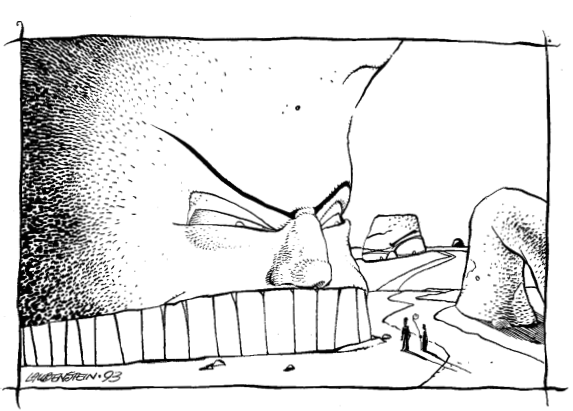
Dismissing The Guardian
I have to say this is probably the most pointless part of the Hunt. It probably serves some kind of metaphorical or meta-fictional role that's going over my head but its still frankly dull, repetitive and serves no understandable purpose within the game world.
The Guardians are beings that are meant to block travel across the Rift of the Neitherspace (whichever the book feels like calling it at the time) by anyone but the Stalkers, the agent of the Primal Powers. Of course, considering that the Unbidden apparently get through all the time without anyone noticing they don't seem to be doing a very good job.
About midway along the Winding Path the Stalkers will encounter a Barrier which may take any metaphorical form (mazes, walls, armies of foes, etc) which is completely and utterly impassible no matter what is attempted. The Guardians maintain the Barrier which may also take just about any big, impressive form. The Guardians are meant to allow Stalkers passage but apparently like to be troublesome despite this.
The actual act of "dismissing the Guardian" is purely one of role-playing, you have to declare your position, purpose and authority in an appropriately dramatic and commanding manner. The book states that this is meant to get players in the mindset of being a Stalker...but considering you have to do this every time you start a Hunt it's going to get old and dull really fast.
Oh, and it mentions that some Guardians are so stubborn that they will not allow Stalkers to pass unless they are injured or even destroyed...except of course there's no means to do this since there are no rules for combat outside of the Realms of Flesh and Guardians are never given any kind of stats.
The Primal Powers are starting to look a bit incompetent here...the entities they set to guard the Rift between Flesh and Essence are so headstrong that sometimes they will utterly refuse passage to the Stalkers on a literal mission from god....but at the same time there's no indication that the Guardians serve their primary purpose of preventing the Unbidden from traveling to the Realm of Flesh, being utterly incapable of preventing them from invading the Realm of Flesh or even warning anyone when they do (since the Calling is purely mortal-based).
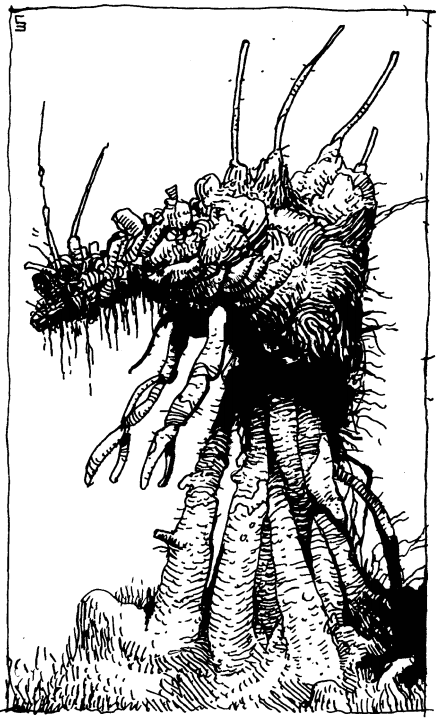
Mending The Enigma
So, if you don't recall, Enigmas are "flaws" in the Realm of Flesh that are created by the loss of one of the Aesthetic Dreamers when they travel across the Rifts, becoming one of the Unbidden. If they aren't Mended Enigmas will spread and start to tear apart the fabric of the Dreaming.
Oh, and apparently Enigmas can also be created by mortal magicians screwing around with stuff they aren't meant to dabble in, especially when rituals are performed in one place for too long (mad science can apparently do something similar). Although its not clear why you would use either of these since this will lead to an extremely short adventure...show up, mend the Enigma and go home.
The Enigmas create problems with the Dream that alters the Vision of the Aesthetics and creates inconsistencies called Anomalies. The most common anomalies are Exaggeration and Simplification, where Corruption...causes small things to become tiny and large things to become enormous. That seems...not very impressive. Then we are told "guns get bigger, nights get darker and cities become labyrinthine". I think the sheer density of jargon in these few paragraphs is starting to Corrupt the Vision of the Author producing Anomalies in their Descriptions of Concepts so they Don't make Sense.
More common Anomalies are your basic "paranormal activity": weird noises, strange fog, odd lights and terribly boring movies. The Corruption will worsen over time but the effect is slowed in places where there are many unEnlightened mortals whose consensus view of reality makes the Dream stronger.
We get another nearly page-long sidebar on Shadowlands, which are areas where the Enigmas have become so strong that they have been rejected by the Realm of Flesh and cast into the Rift. The Shadowlands are no longer subject to normal rules and are only tenuously linked to the Realm of Flesh by a Touchstone which can be used to make a Portal to a Shadowland which are (as the name implies) full of Shadows. It's a really neat concept and would make an interesting concept for an exploration between the Realms of Flesh and Essence where the Stalkers face greater challenges but can also go all-out without having to worry about maintaining their mortal facade....except that none of it matters since all a Stalker needs to do to deal with a Shadowland is to Mend the Enigma which is just a skill check which will destroy the touchstone and collapse the Shadowland. So this entire section is basically pointless.
Then we have a few notes on Enigmas, first the Enigma itself does not mesh with the rest of the Dream so it is not protected by the Forbiddance (we still don't know what that is) and the Veil will conceal them from anyone free of the Corruption (and I'm not sure what that means either). For instance, a place or time subject to an Enigma won't show up in the news or history books because it is not part of the Collective Consciousness.
All Enigmas have a Focus from which Corruption spreads, a physical form which represents the epicenter of the Enigma. This is usually a person or place that doesn't follow the normal rules of reality. Stalkers are forbidden from taking them outside of the Corrupted area to avoid spreading the Corruption. Mortals caught in an Enigma are Corrupted and thus won't realize that Anomalies are unusual...which is odd considering the Call only happens when a Supplicant begs for help due to being endangered or threatened by an Enigma.
It's noted that the Unbidden tend to lair within Enigmas that they created to protect the Focus from Stalkers.
If a Stalker encounters the Focus they can use the Sensitivity skill against a difficult determined by the extent of the Corruption (there are no guidelines provided nor even an indication if more or less Corruption makes this easier or harder). A successful roll tells you if the Enigma was created by an Unbidden and if so where the Unbidden is located, but this also lets the Unbidden know that they are being hunted.
Finally, the actual Mending of an Enigma. Despite this being the 4th step in the Hunt it is actually probably going to be the last thing a Stalker does, because apparently you can't Mend an Enigma until the Unbidden that created it is Bound...and remember that Mending is both a difficult skill and a Strenuous one, and so is Binding. So not only do you have to successfully battle all of the Minions and mortals in your way, defeat the Unbidden themselves and then perform a successful Binding but now you've got to have the Karma and Vitality left in order to actually Mend the Enigma as well.
Of course, if the Enigma is naturally occurring or due to the actions of a mortal then it's just a matter of making a Mending roll as soon as you find the Focus and then fucking off home.
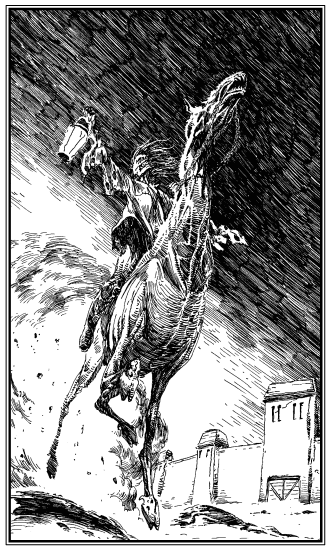
So, I'm wrapping up here for now, next we'll get to the actually important part of the Hunt, dealing with the naughty Unbidden.
The Hunt, continued
Original SA post
The Whispering Vault
Part 7: The Hunt, continued
It's been a while, but last time we started to cover "The Hunt", the unfortunately formulaic procedure for actually playing the game. Since there was quite a gap since the last post here's the summary of what we've covered so far:
*Receiving The Call: A mortal threatened by an Enigma calls or prays for supernatural aid, the call goes to one of the PCs who rounds up their allies.
*Calling The Navigator: The Stalkers summon the Navigator, a big-ass creature which forms a physical bridge between the Realm of Essence and the Realm of Flesh.
*Dismissing The Guardian: Midway along the Navigator's body you are faced with the Guardian, a being who bars your path and must be cowed or beaten. no rules exist for doing either.
*Mending The Enigma: You have to fix the damage caused by the incursion of the Unbidden into the Realm of Flesh. This is actually the last step of the Hunt, but for some reason it's provided before Binding.

Well, now we're here to the main part of the Hunt, Binding The Unbidden.. This is the largest part of the Hunt as it actually contains all the rules for interacting with the Realm of Flesh and definitions of those terms which have been thrown around this whole time.
The Unbidden are the most common source of Enigmas and are generally the only reason worth playing out a Hunt. Theoretically an Enigma can be created through mortal magic or experiments but since there's not really any way for a group of mortals to significantly hinder a Circle of Stalkers and Mending an Enigma is just a matter of a single skill challenge, there's no point in making an adventure without an Unbidden involved.
To Bind an Unbidden you must first defeat its Vessel and force its Avatar to manifest (no, we still haven't covered any info on doing that). Then someone has to use their Binding skill in order to transform the Unbidden into a glowing sphere called the Radiant Orb, which can only be seen by Sensitives and has no physical presence, however Mortals who come in contact with the Orb are burned and risk possession. It can be moved by force of will (presumably only by Stalkers, but this isn't cleared).
Stalkers can communicate with the Unbidden bound within the Orb by touching it and spending a point of Karma, at this point the Unbidden is usually regretting its actions and begging for mercy. It is up to the Inquisitor (I have no idea who this is....this is literally the first and last time the word Inquisitor is used in the book) to determine why the renegade Aesthetic (remember, the Unbidden are Aesthetics gone bad) betrayed the Primal Powers. It seems to be implied that the PCs are meant to hold some kind of trial for the Unbidden, but its not clear. This is especially ridiculous since speaking to the Unbidden is going to automatically cost Karma.
This is also the time when you actually need to Mend Enigmas, so you actually have to tote the Radiant Orb around to find all the problems and patch them up. This section also features some truly terrible page layout. Let me demonstrate:
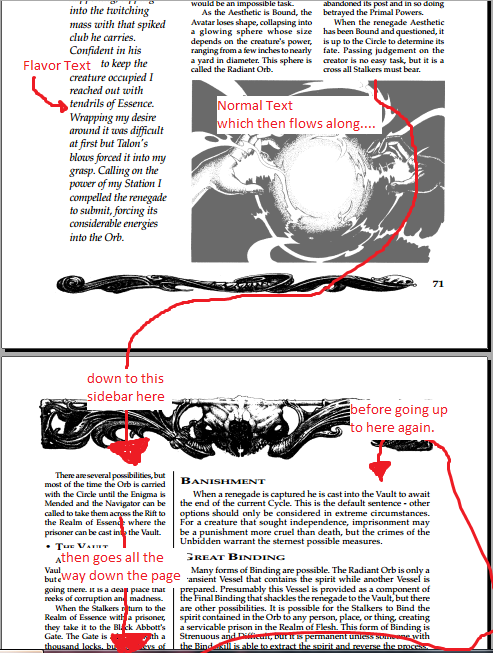
Anyway, now we actually get to the eponymous Whispering Vault itself (well, they call it the Vault, dropping the first part of the title, presumably its the same Vault). This is the standard form of punishment: the Renegade is cast into the Vault to await the end of the current Cycle. The Stalkers take the Radiant Orb back to the Realm of Essence and take it to the Black Abbot's Gate (which is apparently a place, who or what the Black Abbot is will never be addressed). The gate has a thousand locks which can be opened by the Stalker's Keys of Humanity, revealing a bottomless pit where the Unbidden will be cast down.
The "whispering" part apparently comes from the fact that the Vault's security is apparently terrible: some of the imprisoned Aesthetics have learned how to communicate from within the Vault with Mortals in order to tempt them to faustian pacts and apparently there are even mortal rituals which allow Enlightened mortals to break open the Vault to free one of the Unbidden and bring them back to the Realm of Flesh. You'd think after countless millennia and endless Cycles of universal creation and destruction one of the Primal Powers might notice this problem and maybe soundproof the Vault a bit better.
Oh, and we've got a random bit of weirdness here at the end of this section. Apparently the symbol on the cover is the Sanguine Seal which is carved on the front of the Black Abbot's Gate. This apparently repulses escaped spirits and they avoid all contact with it. A seal carved by an Enlightened mortal Sensitive on a door has the power to reduce the prisoner's Fortitude by a point (does this work on any prisoner? anyone who sees the symbol? can Stalkers do that? what about Unbidden who haven't been in the Vault?).
While being cast into the Vault is the default sentence there are a couple of other choices a Stalker could make when dealing with one of the Unbidden.
Great Binding: Normally Binding sticks the Unbidden into a Transient Vessel for easy transport, but you can also choose to perform a Greater Binding, trapping the Unbidden permanently in a physical form in the Realm of Flesh to a person, place or object. It's honestly not clear why anyone would do this, since the entire point of a Stalker's service is to prevent the Aesthetics from ditching their job and going to the Realm of Flesh. The Greater Binding is Strenuous and Difficult...except Difficult isn't a game term. Difficult y refers to the target number of an action, but it's not a rating by itself.
Bestowing Mortality: This process has the disturbing name of "Fleshing" and is apparently so rare that many Stalkers don't even believe it is real. This involves purging most of an Aesthetic's Essence and binding it to a Flesh Vessel. This is a Strenuous task and has a Difficulty of 18 (see, that's how it works). This turns the Aesthetic into a mortal (a Sensitive mortal and an exceptional one). There''s honestly no reason to ever do this, since it costs you half your Karma reward for the Hunt. And to be clear, there is never any time where the Unbidden are presented as sympathetic or worthy of mercy...the mere act of coming to the Realm of Flesh is a crime against nature and when they get here they're universally presented as horrific beings of perverted hunger. Why would you sacrifice a good chunk of your reward to give them exactly what they want?
Execution: Unlike Greater Binding or transforming an Aesthetic into a mortal, this option is at least understandable. After seeing the horrors inflicted by one of the Unbidden or spending a Hunt being battered and frustrated the desire to just plain kill the bastard is understandable (especially since they might have already escaped from the Whispering Vault once or twice already). However, it is a violation of the laws of the universe as, despite their crimes, the Unbidden are pillars of creation. In order to do this you must first turn them into a Mortal and then each member of the Circle must strike the Unbidden three times with a mortal weapon, focusing their will upon its death. As this is a violation of their duty this costs 1 Karma to each member of the Circle and you earn no Karma for the Hunt.
By the way, it is never mentioned what happens if you Bestow Mortality on an Unbidden and they get shot by another mortal or merely die of old age (after all, that's what mortality means). The Execution option seems to imply that the only way an Unbidden may be killed is by the ritual act of a circle of Stalkers, so do they return back to the Realm of Essence if they're killed otherwise? are they actually immortal?

Well, after covering the steps of the Hunt the rest of the chapter covers two important pieces of info that have been mentioned before but never actually defined: the Veil and the Forbiddance.
The Veil: So, apparently part of the Living Dream of the Aesthetics not only creates the Realm of Flesh but it also works to make mortals ignore anything that doesn't quite make sense or doesn't align with the Dreaming. This is called the Veil. Basically, it forces non-Sensitive mortals to ignore or rationalize the supernatural and beings of Essence. This only affects mortals and beings of Flesh, Stalkers are able to ignore the Veil but do benefit from it.
This effect is retroactive as well, even if a crowd witnesses an undeniably supernatural event (say a group of Stalkers going "all out") then they'll eventually rationalize or misremember it enough that it eventually becomes little more than rumor or myth. This even affects those who "want to believe" the truth...things will get fuzzier or more vague so they can no longer convince other mortals of the truth. This also includes things like video or photos, where beings of Essence will only appear as indistinct blurs, static or similar errors and most who see this will not be convinced that these aren't simply normal photo errors or hoaxes.
Now, apparently beings of Essence benefit from a kind of camouflage, where mortals can perceive them but not find anything notable about them and they are assumed to "belong". It's an interesting mechanic but it is poorly defined, does this mean a Stalker can walk into a police station and start rummaging around in the evidence room? Or walk down main street carrying a zweihander and a rocket launcher? What about indirect actions...does this still work if a Stalker is driving a car somewhere they shouldn't? If two beings of Essence are fighting one another will anyone notice?
There's a second "level" to the Veil called The Mask. Stalkers can choose to Mask themselves, it removes the protection of the Veil but allows them to pass as mortals and interact with mortals. Players should describe how they look in their Mask, they will always look like mortals but will always "stand out" a bit. The Mask is also a bit more unstable than the Veil as there's a chance for mortals to see through it. Whenever a Stalker challenges the illusion of normalcy they must make a Masking skill roll and if it fails the Mask drops completely, revealing their Vessel for anyone to see.
Dropping the Veil (whether intentionally or by failing a Masking roll) is a dramatic, significant event and mortals who witness your Vessel become more resistant to the Veil for the next few days (making it possible for them to recognize you if they spot you later). It's only possible to raise the Veil by getting to a place where no mortal can see you for several minutes.
So, this brings up a topic, what does your Vessel look like? We know that Avatars can look plain crazy-pants because they are beings of Essence and represent the Stalkers "inner being"

Left guy's inner being apparently is "spiky baseball"?
But the Vessel is not just the physical form of your Avatar. You get to customize your Vessel's physical attributes every time it's created by the Weavers but no mention is ever made of the Vessel's actual appearance, presumably a stronger or tougher Vessel looks bulkier or more muscular and naturally Disciplines like Savage include something like claws or knife hands. But assuming you don't have any blatant physical Disciplines, why would you want to build an obviously inhuman vessel? I could understand that some elements are always going to look weird or unusual (Weavers don't necessarily "get" humans after all) but why build a Vessel that tells everyone within a hundred feet that you're a freak? You've got a job to do after all. Two-heads guy isn't doing anyone any favors:

But other than these pictures, we've actually got no guidelines on what your Vessel looks like. There's a few paragraphs in character creation talking about what your Avatar should look like (the form you wear in the Realm of Essence, i.e. the Realm Where Nothing Happens) but it's never actually addressed how that translates to your Vessel. And the pictures range from the freakish (like two-heads and fish-gal) to the nearly normal:
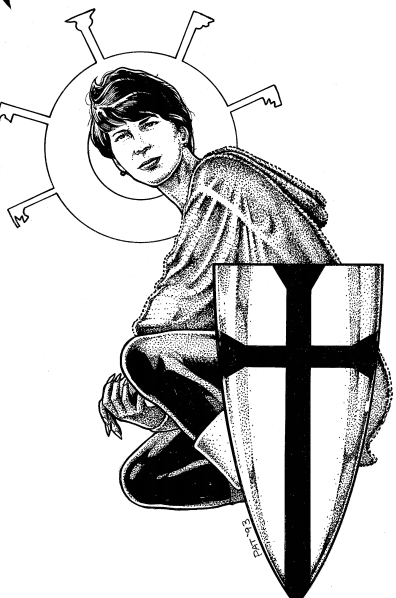


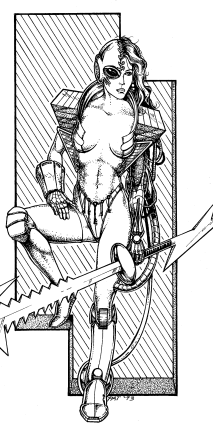
The biggest problem is that this is simply not addressed in the rules at all, a rather glaring omission.
Anyway, on to the Forbiddance. These are the rules that Stalkers must live by within the Realm of Flesh in order to protect the sanctity of the Dreaming. The severity of the Forbiddance can be adjusted by the gamemaster to created a more subdued experience or a more gonzo "all out" game. There are two basic rules:
The first rule is that the Stalkers must respect the sanctity of the Chronosphere, basically no changing major historical elements. The Dreaming adapts so there will be no "butterfly effect" to worry about, but Stalkers aren't allowed to do things like knock off Hitler if they end up in WW2 or Stalkers from the future introducing advanced technologies to the past.
The second is that Stalkers should leave mortal lives as undisturbed as possible. No casual mass murder or interfering in mortal affairs that aren't a part of the Hunt. You can certainly kill mortals in thrall to the Unbidden, aid mortals who are endangered by Enigmas or Shadows, but don't start Dominating people for entertainment or killing uninvolved mortals who you simply find morally repugnant.
Once a rule is broken the Forbiddance has four stages:
The first stage is Aversion, also called "The Fever" which manifests as a dull ache in the fingertips that spreads over the Vessel. This is basically a warning from the GM that whatever the Stalker is about to do is going to be a violation.
The next stage is Torment, which occurs if the Aversion is ignored (or if there is no chance of a warning in the first place). This is a searing pain which increases all Difficulties by 2 and you cannot use any Karma points. This will fade in 1-6 rounds if you back off or if the offense is minor, but it can last for hours for more serious affronts.
The third stage is Backlash, which inflicts a point of Vitality damage every round until you back off. This is invoked when the Stalker knows what they're doing but continues to try anyway.
The final stage is intercession, the Primal Powers destroy the Stalker's vessel and bring their Avatar back to their Domain. The first time this happens the Avatar is allowed to continue to serve so long as they respect the warning. However, a second offense is going to get the Avatar destroyed or cast into the Vault themselves and all who knew them will be forbidden from speaking their name ever again.
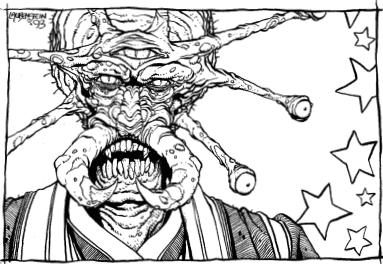
Finally we are done with the Hunt chapter, next we'll cover the GMing section for long-term gaming.
Post
Original SA post The Whispering Vault: Once More Unto The Breach
So, it’s been a while. Life, time, ceaseless march to the grave, all that.
Anyway, let’s try to futilely distract ourselves from our own decaying shells by griping about bad design in mid-90s RPGs!
For those who have understandably forgotten all about Whispering Vault, previous Fatal and Friends entries are here.

Now, we’ve got the “Game-masters” section for the Whispering Vault, i.e. the boring speed bump on the way to the chapters about Shadows and the Unbidden. We are told here that Whispering Vault is apparently designed for non-continous “pick up” games, with new characters made for each session. Which makes a certain amount of sense given the formulaic nature of the Hunts...but it’s also something that should really have been mentioned already.
However, for those weirdos who like to play more than one session at a time, there are rules for gaining XP and Karma.
If you recall, Karma is the game’s meta-currency like bennies or fate points. Karma is not a “per session” or “per hunt” thing, it’s actually tracked persistently, meaning that bad luck or bad decisions could leave you completely dry for several sessions. Even worse, it’s actually possible to earn no Karma for a session if you violate the forbiddance, which means you’re probably completely dry for the next session. I mean, nothing wrong with having rules of behavior in the game, but at this point you’re really punishing the player rather than the character.
Next we’ve got XP. Whispering Vault does the thing a lot of games did post-D&D where they get huffy over the idea of awarding XP based on opponents defeated and instead award XP based purely on “roleplaying”. This leads to the unfortunate situation where the GM has to stand in judgement of a player’s performance, based on how well they stay in character, how well they fit the themes of whispering vault and how much they contribute to the success of the adventure.
XP can be spent to improve a skill (new bonus x2), learn a new Discpline (number of disciplines x3), master a discipline (15 xp), get a new servitor (# of servitors x4) or master a servitor (10 xp). Finally you can increase vitality (xp equal to the new vitality score, and almost certainly your first priority).
You can also potentially improve your attributes...except they decline to actually give a ruling on how much this should cost, saying that it should probably be between 5 to 10 times the new cost. Might as well just not allow it at this point.
Oh and finally there is an option for character “advancement”, becoming one of the Aesthetics. This is done by spending Karma to “purge” your Keys of Humanity, with each key costing 5+5 per Key already purged (so 5 for the first, 10 for the second, etc). Each key also grants a +1 to Awareness and Insight skills but causes you to lose a point from your physical attributes (which quickly becomes crippling). Your reward for doing this is having your Stalker ascend to the role of an Aesthetic and no longer being a character. It doesn’t really seem like something you should have to “earn”...why not just have that be an option available if you choose to retire your character?

Now, next we have a legitimately interesting option, Group Powers which allow the Circle to develop special communal abilities.
Group Powers are a pain to get: first, everyone has to spend 5 Karma to buy one, and Karma isn’t so readily available that it’s easy to have 5 on hand for everyone without making the next Hunter much tougher. Circles can only buy one Group Power at a time and only after impressing the Primal Powers, completing a Hunt that earns 7+ Karma...for context, most Hunts are worth 5 or less Karma and players generally can’t do anything to influence the amount of Karma earned: Karma rewards are based purely on the amount of challenge the GM chooses to create (minus any penalties they might get for not following the rules).
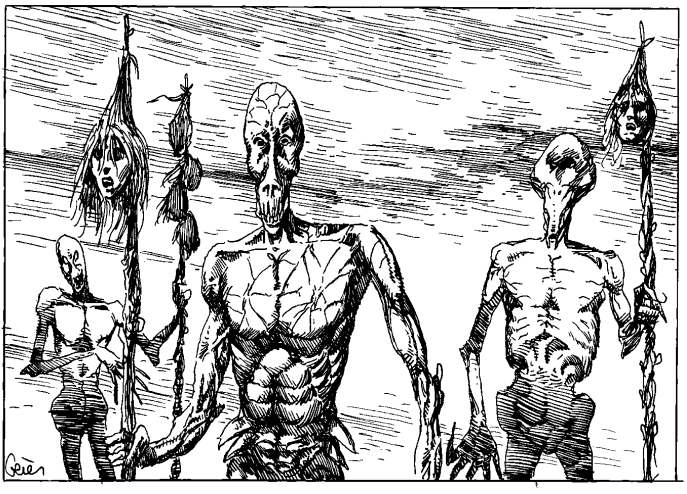
So, let’s take a look at the group powers and see if they’re worth it.
Blood Bond: Blood Bond allows you to “share” Vitality among one another. At first this would seem pretty useful, given the low amount of Vitality available to most Stalkers and the way their powers are often hungry for it. However, actually donating Vitality is a strenous action, meaning it costs a point of vitality on top of the vitality you’re already giving up. It compares poorly to Weaving...and Weaving already sucks. On top of that, if a stalker “dies” then the remaining members of the Circle not only lose a point of Vitality and lose their next action...making it quite easy for another character to die, inflicting more damage to the group and keeping them stun-locked for another round.
Calling Circle: This lets you do a communal summoning ritual when summoning Servitors. Although the actual text is confusing what seems to happen is that everyone involved has to spend an action but only one has to spend Vitality, then everyone rolls and takes the highest result to determine success (and if one of the participants has Mastered the servitor they don’t have to spend vitality). One big problem...in order to do this everyone involved has to have the same Servitor...which is a terrible idea. There’s almost no reason why more than one member of the circle would have “overlapping” servitors.
Closed Circuit: This power functions only with Rend (the ranged attack Discipline) and lets the Circle pull a Power Rangers team-up and combine their Rend power into a single uber-attack. All Stalkers involved must have Rend and must be able to see each other. The willpower attributes of everyone involved are added to determine damage but the participant with the highest Willpower is the one that has to make the Attack roll, even if they don’t have the highest Attack skill. This stands out as a powerful attack...Stalkers probably have a Willpower of about 6, meaning just three Stalkers teaming up inflict damage equivalent to a rocket launcher. A full circle of four or five starts doing damage equivalent to artillery weapons...way more than most enemies can deal with. So, third times the charm as far as useful team powers.
Frightful Unity: This lets Stalkers combine their form into a single gestalt entity. This takes a while (1d6 rounds). The entity has the best Dex, the combination of the two best fortitude scores and the three highest strength scores. Vitality is the total of all stalkers. This makes for a hefty power-up, but the loss of extra actions doesn’t really make up for it and only one character can control the gestalt at a time, using their skills and disciplines. The biggest benefit is the ability to combine up to three character’s Strength scores for big unarmed attacks...except Strength is already the least desirable stat and it’ll generally be a character’s lowest physical stat.
Helping Hand: This is something that really should just be available to anyone in a team-based game. It’s your basic teamwork rule...sacrifice your action to give another character a +1 bonus to their action, up to a maximum of +3. This is particularly useful out of combat (allowing teams to ensure that important skill challenges like Binding and Mending succeed). This is practically essential for that reason...so much so that it really needs to be the first Circle Power purchased.
Karma Pool: This creates a “team Karma” pool which anyone can draw from, but must be filled by donated Karma from the team. The main benefit is that if everyone donates at least one point of Karma at the end of the hunt an extra Karma point gets added in by the Powers. Generally speaking there’s no reason not to just pour all your Karma right into the team pool so its rather odd that they didn’t just allow players to freely swap Karma...only the most PVP teams would have any problems with donating Karma to a teammate when needed.
Shared Perceptions: Lets the team share their senses, seeing through each others eyes and so on. Doing so is distracting, inflicting a penalty if you’re trying to do things while sharing a teammate’s senses.
Shared Vessel: This allows you to abandon your Vessel to move to another Stalker’s Vessel, sharing their body. This gives no benefit to the new Vessel, it’s merely a way to ensure that a badly wounded Stalker doesn’t get banished (probably as a way to ensure that a Stalker with essential skills like Binding or Mending doesn’t get lost). The two STalkers can “swap” back and forth to allow the dominant one to use their skills and disciplines.
Vital Tribute: This basically lets you sacrifice Vitality for Karma...and is almost certainly a terrible idea given how low on Vitality all Stalkers are. The first time you do it you can sacrifice 1 Vitality for a point of Karma, but the cost increases by 1 Vitality the next time (2:1) then goes to 3:1 and so on. So yeah, not a great move.
So, much like Disciplines and Servitors the group powers range from worthless to almost indispensable.
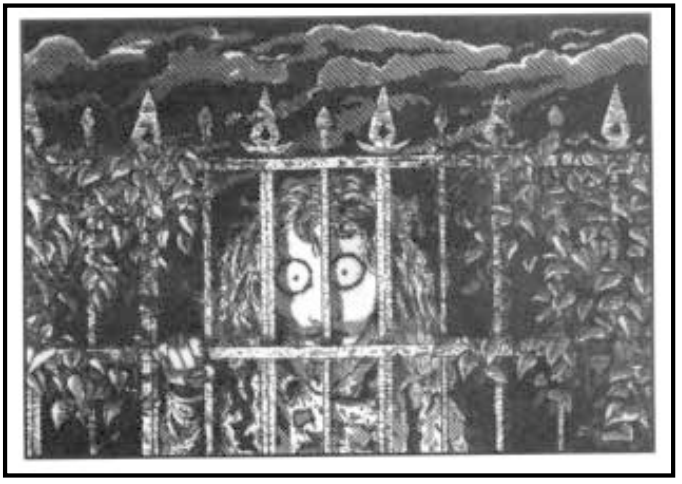
Watchers
This is an interesting campaign alternative...the Watcher style campaign involves a Circle of Stalkers assigned to a “hot spot” in the Realm of Flesh where Enigmas or Shadow intrusions are more typical for whatever reason, requiring a full-time Circle of Stalkers keeping an eye on it. This is kind of ideal for a long-running campaign allowing Stalkers to deal with things like the consequences of their actions on an area or building relationships with Mortals.
Unfortunately they fail to provide any rules for things like healing or re-making your Vessel, normally an essential process that is handled at the start of the Hunt, but is impossible during the game.
What there are rules for are creating Sanctums, a shelter in the mortal world for a Stalker Circle, their cenobyte Hall of Justice.
Sanctums also get Enhancements, which must be bought with Karma (1/Stalker for the first enhancement, increasing to 2/stalker for the second and so on). The enhancement list is actually bigger than the Circle Powers list:
Cloaked: The sanctum is super-stealthy and any mortals who finds it or goes inside will forget about it after they leave.
Conscious: Your Sanctum has a mind, called the Keeper, which can manifest within the Sanctum. The Keeper is damn impressive, with an Initiative, Perceive and Resolve attribute of 12 and these stats will supposedly improve. You can spend a second enhancement to give the Keeper the Rend discipline.
Elusive: This enhancement makes it impossible for mortals to find their way to the Sanctum on their own.
Infested: These sanctums are Hives (capitalized for some reason) which produce Drones (also capitalized) who are basically supernatural butlers. They have no effective stats or bonuses.
Invasive This lets your Sanctum create portals to anywhere within your area of protection, making it easy for you to show up wherever you need to. These portals have to be established to fixed locations and you get a number of portals equal to the Willpower score of the Stalker with the highest Insight.
Linked This gives the sanctum a gate directly to the Realm of Essence, for those too lazy to summon a navigator.
Labyrinthine The third “confuse mortal” enhancement, which is largely pointless. Basically the interior of your Sanctum is so confusing mortals become trapped and cannot find their way anywhere.
Nurturing Well here are those rules I was talking about This enhancement allows you to regenerate, every hour spent in the Sanctum will recover a point of Vitality and once you’re healed you can start recovering lost attribute points at the rate of 1/day. This enhancement is so essential that it should really be a default.
Persistent This enhancement lets your Sanctum regenerate itself, restoring itself if damaged or destroyed.
Transcendent The Tardis enhancement, its bigger on the inside. Thats really all.
Transitory: You can shift the Sanctum to a new building...and it sucks because every time you move to a new building every Circle member has to spend 1 point of Karma for every Enhancement on the Sanctum...ie the same cost as a actually purchasing an Enhancement for the amazing power of moving down the street.
Venomous This power renders Labyrinthine extra pointless by simply ensuring that anyone who invades the Sanctum without permission will be crippled and eventually killed by blinding pain.
So Sanctum Enhancements are neat, but quickly become not worth the cost thanks to the increasingly escalating cost. Since every Circle member pays that means a four person Circle with two enhancements already has to spend a total of 12 Karma among themselves for a third Enhancement, Karma that could really be used for anything actually useful. There’s really just one or two Enhancements that are actually functional and the rest just fall under the category of “neat stuff”.
Post
Original SA post
The Whispering Vault, Another One
The Unbidden

So, as previously mentioned the Unbidden are the world-dreaming Aesthetics who create the Realms Of Flesh on behalf of the Primal Powers. Occasionally (well, it seems quite often) one of them gets obsessed with the Realm of Flesh and will leave their post in the Realm of Essence, coming to our world and becoming one of the Unbidden.
Now despite the book’s creepy description (“indulging their passions” and “unnatural lust”), things fortunately do not seem to go all Black Tokyo with the Unbidden, they mostly seem to just kill people.
When the Unbidden come to the Realm of Flesh they go through a “life cycle” as they adapt. They start as Beasts, basically flesh eating monsters who consume mortal life force to survive. Once they’ve eaten their fill they become Strangers, where they regain enough clarity to start acting on their Passions rather than mindlessly killing. Strangers who “mature” enough can become Architects, who are more master-mindy and start developing long-term goals and ambitions as well as more influence in the mortal world.
Essentially, each stage is meant to be a different sort of Hunt, a Beast is a ravening killer on the loose, a Stranger is more of a serial killer that must be hunted down and the Architect has imbedded themselves in mortal society, becoming harder to assault directly.
Before getting into more detail we’re thrown into a sidebar about Aversions. An Aversion is a typical “cross to a vampire” style weakness that some Unbidden have. There is no clear answer on why...it’s just a thing that happens. Likewise intensity can range from mild discomfort to paralyzing fear.
Oh and apparently many (but not all?) Unbidden have an Aversion for the Keys Of Humanity, which is a powerful tool since it could allow Stalkers to do a kind of ‘turn undead’ move on the Unbidden. Except there are no actual rules for it. The game devotes two paragraphs to telling us about it but forgot to actually provide any rules for what will happen if you try and shake your Keys in Cthulhu’s face.
Then we’re told about Fetishes, which are called “Lesser Passions”...well, they call them that but the term seems to be synonymous with Passions. There’s nothing to clarify what a Passion is if the Fetishes are “Lesser Passions”. There are also no rules here, it just points out that all Unbidden have at least one and may develop more as they grow.
Finally we have Idiosyncrasies which are basically the behavioral signs that the Unbidden are supernatural weirdos. Again, no rules, but this section didn’t really require even mentioning. I think by now it was assumed that the Unbidden would be strange in a variety of ways. If there’s one thing this game doesn’t need it’s another Capitalized Word.

Now we get back to the Unbidden life-cycle.
The Beast
The Beast is the first stage of the Unbidden life cycle. Right after crossing over to the Realm of Flesh, the Unbidden finds the nearest Mortal and goes all “edgar-suit” on them. This kills the Host and destroys their soul.
The Host body starts looking traditionally undead (referred to as The Ashen Mask) and becomes supernaturally strong and killy. Every 1d6 days the Host loses a permanent point of Vitality as the Withering causes the Unbidden’s stolen body to decay, unable to bear its Immortal Essence. The Withering can eventually destroy the Host entirely and if the Unbidden hasn’t managed to evolve to the next stage then its Avatar will go on a rampage until it starves in a few days (usually killing everything nearby).
The Beast feeds on Mortals using its Vampiric Touch, draining 1 point of Vitality every 3 rounds (so not really useful in combat). Humans who aren’t killed can recover with rest, so long as their spirits haven’t been broken (Driven Mortals recover twice as fast. This is important for some reason). Those who survive being drained have a kind of mind-link with the Beast, dreaming of them and their doings.
So yeah, basically Beasts are non-sexy vampires.
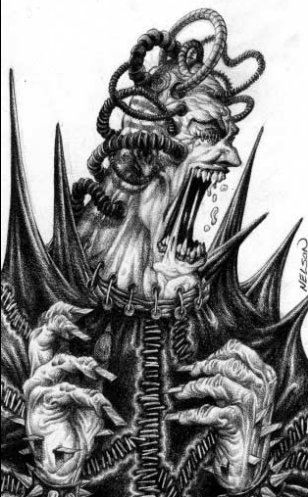
Bella!!
Because of the Beast’s constant Hunger there’s not much it does other than feeding on Mortals, although when it’s fed it becomes slightly more lucid (possibly with some of the Host’s memories and personality leaking through).
This stage of the Unbidden is a straight-up monster hunt for the most part. It’s also the shortest stage, the Unbidden either learns how to feed on Essence rather than Flesh within a few weeks or they die from the Withering. If you catch an Unbidden at this point you have a chance to nip things in the bud.
Stat-wise the Unbidden follow an interesting pattern, the more integrated they become the more powerful their Host is but the weaker their Avatar is. So the Beast has a relatively weak Host body but once defeated as a Host their Avatar is exceptionally strong.
This actually makes a Beast really difficult to deal with, since they have the most extreme stats once their Husk is wrecked and they are forced into Avatar form, largely their massive resolve of 23, which is going to be the target number for the Binding action used to seal up an Unbidden. Keep in mind that the highest TN a normal task goes to is 18.
Assuming a character is absolutely focused on Binding might have a presence of 6 or 7 (so rolling that many dice) with a +6 bonus to the total from a maxed-out Binding skill, meaning you need a result of 17 or higher in order to Bind a Beast.
I...think that’s nearly impossible?
I say “I think” because figuring out the odds for a roll in Whispering Vault is really tough. If you don’t remember (and I don’t blame you), a roll is done by rolling a number of d6’s equal to the stat your roll is based on. You take the highest single result or you add together any matched results. You then add a flat bonus from skills on top.
So, assuming you’ve got Resolve of 7, you’re rolling 7d6s and in order to beat a 17 or higher (assuming that +6 bonus from Binding skill) you’ve got to get either three+ 6’s, four+ 5’s, five+ 4’s or six+ 3’s. Those are the only results that can give you enough to succeed.
I don’t know the odds, someone with better dice fu can feel free to work it out but I have a strong feeling that it’s not a reasonable difficulty for an essential roll. And keep in mind this is for someone with maxed out Binding, a skill that has no other use. It’s an important skill, but this is the only time you’ll be doing it. Oh, and remember that Binding is a Strenous skill which means that it costs you Vitality to use, so if the Bind-monkey has been taken out or badly hurt already your team may find it impossible to Bind your opponent even after beating them.
Of course, copious Karma spending can get you through, but again you run into the problem that this is the last thing you do in the Hunt more or less, you’ve just finished your “boss fight” and may not have the karma to spare to beat a number this unreasonable.
Ironically this leaves the only option to be killing the Unbidden, which results in you losing your Karma reward for the whole Hunt.
The Stranger
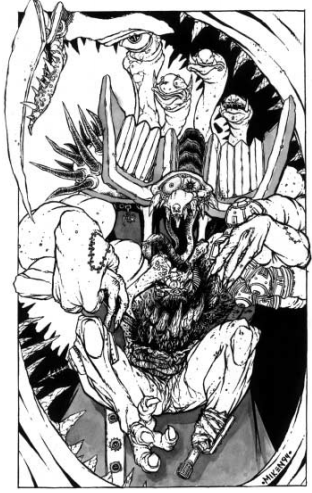
This is what happens if you sit on your hand too long
If the Beast manages to adapt to the Realm of Flesh and starts absorbing Essence to sustain itself its hunger is sated and it becomes The Stranger, ready to indulge in its Passions.
The Stranger can absorb Essence by feeding which slows the effect of the Withering (1 point of Vitality every 1d6 weeks) and even more dangerous it can transfer its Avatar to another Vessel whenever it wants (although the process requires about 30 minutes of uninterrupted contact with its new body).
The Stranger can also spend Vitality to strengthen its Vessel, increasing its Strength and using the Avatar’s defence, attack and initiative scores instead of its Vessel. For two vitality strength goes up further and it gets to make two attacks per round.
The Stranger can also start Binding Shadows to serve as Minions (3 points of Vitality). It’s arguable how worthwhile this is since each Minion bound reduces the Vitality or Resolve of both the Vessel and the Avatar by 1. Although once the Minion is banished or dead the lost points return after 1d6 hours, making it okay for short term servants.
Behavior-wise the Stranger is more serial killer than rabid monster. They don’t properly understand mortal society or behavior and largely just act to fulfill their Passions, moving to a new Vessel once it gives out or the Stranger attracts too much attention.
Moving to the next stage requires the Stranger to come to understand the mortal mind, something that can take decades, if it ever happens. Stat wise the stranger’s avatar is stronger than its Vessel but not to the degree of the beast, giving it a slightly more bind-able 20 Resolve.
The Architect
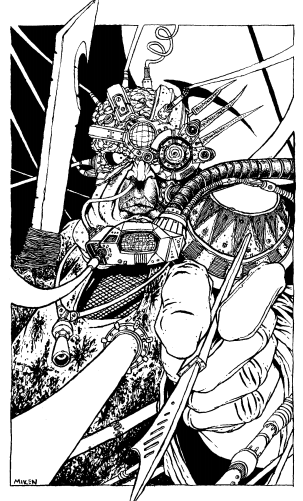
He who controls the Spice, controls the universe!
The final stage allows the Unbidden to fully accept the Realm of Flesh as their home, which features several useful adaptations and some weaknesses.
First, the Vessel no longer suffers from the Withering and is effectively immortal. The Unbidden can even recover Vitality with meditation. The Archetype has the strongest Vessel stats as well, sometimes even higher than their Avatar’s. The downside is that they can only transfer to a new Vessel if their current one is destroyed and their Avatar stats are significantly weaker than the Beast or Stranger stages. This makes the Architect the easiest to defeat in combat.
Second, the Architect regains the power of the Dreaming and can create a Domain (often linked to the Enigma they generate) which is under their control. They can also Bind an unlimited number of Shadows as Minions. Given the fact that most Architects have been around decades or centuries this means they usually have dozens of Mortal and Shadow servants to defend itself and a private realm with conveniently altered physics.
Having completely adopted the Realm of Flesh, Unbidden in this stage usually engage in very long-range plans: getting more Unbidden into the world, forming Mortal cults, etc.
Special Abilities
These are the Unbidden equivalent to Stalker Disciplines.They get more the longer they stay around: Beasts may develop one just before transitioning to Stranger while an experienced Architect may have more than 6. Of course only six powers are provided but it’s encouraged that each Unbidden have a custom power made by the GM anyway.
Chameleon: Exactly what it implies. Stalkers can only perceive the Unbidden with a Difficult Sensitivity challenge...which I guess must be an editing mistake because there is no such thing as a Difficult challenge. Challenges have a Difficulty which ranges from Routine to Very Hard...and challenges can be Strenuous (costing Vitality)...but a Difficult challenge is just not a thing. Anyway, no actual rules or bonuses are provided for this invisibility, which is also kind of a big deal.
Healer This lets an Unbidden fix up their Minions, spending 2 Vitality to heal 5 if you can touch them or 1 Vitality to heal 2 at a range.
Parasite The opposite, you can eat your Minions to heal yourself, gaining 2 Vitality for every 5 drained from a Minion (or 1:3) at a range. The master gets a bonus vitality if this kills the Minion. Be very careful fighting an Architect when they’ve got a swarm of Minions to provide for them.
Puppetmaster This lets an Unbidden piggyback a Minion, sharing their senses and controlling them. Beyond knowing what is happening there are no real benefits to this, especially since the master loses a point of Vitality whenever the Minion is wounded, and 1d6 vitality if the minion is killed. Heck, this could potentially kill a Stranger’s Vessel all on its own.
Shapeshifter This lets the Unbidden change the shape of their Vessel, the bigger the changes the more Vitality this costs and the shorter the effect lasts. Changing to a different person costs 1 Vitality and lasts a day or so, while turning into an object costs 3 Vitality and lasts a few minutes.
Summoner This power will summon Minions, teleporting them to the Unbidden’s side. This costs a point of Vitality and inflicts 1d6 damage to the Minion. Making this kind of terrible. It’s worth noting that so far 3 out of 5 of the powers all focus on Minions, all cost a lot of Vitality and aren’t very interesting. Nothing even basic but useful like Rend or Frenzy from the Stalker’s disciplines.
Weaver This lets the Unbidden Weave a Husk for a Minion which will make them appear human enough that they are under the protection of the Veil. This lets your Shadow Minions pass for human.
Life Link
This refers to an Unbidden’s link with the Enigma that they spawned when they left their post. This has no real effect until the Architect stage, which turns them into super-bosses for experienced Stalkers to fight. The Life Link gives several big benefits:
*Bonus vitality, from 2-6 depending on the strength of the Enigma, halved if further than a mile away but doubled within a hundred yards.
*Custom anomalies. Vaguely defined but seems to cover changing reality in the area of the Enigma in ways that suit them.
*Unlimited minions. This gives the Architect unlimited Minions. An ability they already had. It also apparently allows them to prevent their Minions from Reawakening, something that has not been discussed yet but costs 1d6 Vitality.
*Regeneration. Another ability the Architect already has...I guess this version is slightly better? 1 Vitality every 10 minutes rather than 3 Vitality every 10 minutes of meditation. The big thing is regenerating a Vitality every round if they are within 100 yards of the Enigma. If in physical contact the Unbidden can drain 1d6 vitality...but a roll of 6 screws up and inflicts 2d6 vitality instead.
So...useful but not as dramatic as the game plays it up to be.
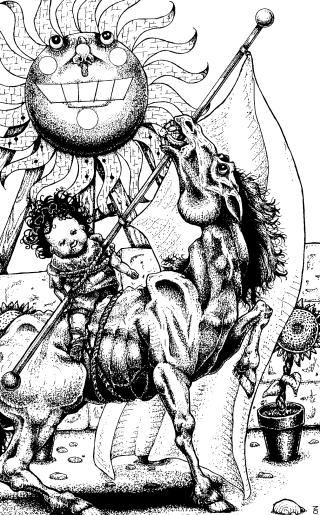
Spooky Shadows
Original SA post
Whispering Vault: Spooky Shadows
Now we’re on to the Shadows. Weirdly the Shadows are actually a lot more interesting than the main foes, the Unbidden. Partially this is because there’s more actual detail and variety on display for Shadows and while Unbidden typically get locked up in the Whispering Vault the Shadows just get cast back into the Rift, giving them the most potential as recurring characters.

So, what are Shadows? Basically they are things that were never meant to be. If the Realm of Flesh is the product of the Aesthetics Dreaming the shadows are a product of their nightmares.
Which brings up a weird thought...why does the Realm of Flesh have to be so boring? I mean the entire premise of the setting is that the Primal Powers start off floating alone in the void and so they create the Aesthetics in order to then have the Realm of Flesh created (because reasons). The Realm of Flesh is basically the real world, with humans, dogs, whatever.
But thinking about it...everything “unusual” about the Realm of Flesh is the result of a mistake. It’s not a secret monsters setting on its own, the only reason for anything supernatural are either the Unbidden mucking about, Shadows mucking about or Mortals figuring out how to summon Shadows or The Unbidden (who then muck about) and finally Stalkers coming along to stop all the mucking about. Also other than the Stalkers, anything supernatural seems to be only interested in eating people.
But why are the Primal Powers so into their weird Sims game? The implication is that they’ve done this countless times as the universe ends and begins again, as it says that the Realm of Flesh is based on their memories of the last universe. They’re like really boring historical re-enactors and the Stalkers are assigned the task of keeping anything remotely interesting from getting into their Pens and Paperwork game.
Anyway, aside over...Shadows. Shadows live in the Neitherspace of the Rift, between the Realms of Flesh and Essence. Since they are a bit of both they can drift along the borders of either Realm, observing mortal activity in the Realm of Flesh seems to be their favorite past-time. Theoretically these drifting Shadows can be communicated with and serve as a source of information but their general weirdness makes it unlikely that they’ll provide any useful insight.
Shadows can Awaken under the right circumstances, forcing their way into the Realm of Flesh. Sometimes this happens due to “natural” events in the Realm of Flesh, and Mortals in the know may arrange these events to ensure the creation of Awakened Shadows as a summoning ritual.
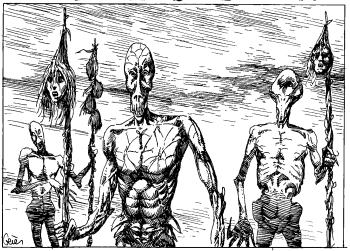
Of course the main source of Shadow antagonists are the Minions of the Unbidden. Binding a Shadow basically crushes its will, meaning they serve with total loyalty but once their physical form is destroyed they may be pissed off enough at their former master to Awaken on their own and make a new physical form for revenge.
Because Shadows seem to look universally monstrous the Unbidden must construct Husks that make them resemble humans (according to the Unbidden chapter only Architects can do this). This Husk won’t survive any damage however, so if the Shadow is damaged it will claw its way out, revealing its normal form.
There’s some guidelines on making Shadows, mostly consisting of just assigning traits based on how difficult you want something to be or how much average damage your PCs inflict.
Then we have some example Shadows:
Gavandhar (Behemoths)

These guys are fucking bonkers. Including one of them would take your game from “surreal cenobyte bounty hunters” to “weirdos with rocket launchers”. Behemoths are huge shadows with an apparent thing for ancient, abandoned ruins. Fitting their huge body into a human Husk requires them to be bound with twenty-eight leather straps and the result is still barely passable as an obese human from a distance.
Stat-wise Behemoths are a far tougher fight than most Unbidden, coming with a Fortitude of 30! For those that don’t remember how damage works this means that you have to come up with a roll of 30 or higher (5d6 is “average” damage for a Stalker, with 8d6 being about as high as possible) on damage to inflict any Vitality loss at all. Anything less is going to be completely ignored. This means most attacks will inflict 0 Vitality, with a lucky blow inflicting 1 Vitality (2 is basically impossible). The Behemoth has 12 that you need to carve through.
Attack-wise the behemoth gets 3 attacks per round, inflicting good damage with each and inflicts an extra -1 die cap to firearms.
So yeah, right out the gate maybe a tad overpowered, especially since they make their boss look like a chump in comparison.
Athkar (phantasm)
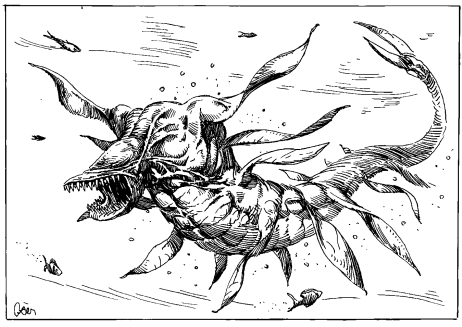
Athkar are Shadows that haunt mental institutions and people of poor mental health, making them worse. If they manage to get anyone to kill themselves they Awaken and go on the hunt for more human misery and death. Even Awakened they are invisible and intangible to anyone who isn’t Sensitive and mostly work by causing hallucinations which only really affect mortals. The Unbidden can bind them into the bodies of weird-looking birds and mostly use them as guard-dogs to keep mortals out or to get high off of the Athkar’s hallucinations.
Stat-wise they aren’t much threat to a Stalker.
Bazreth (Bogey Men)
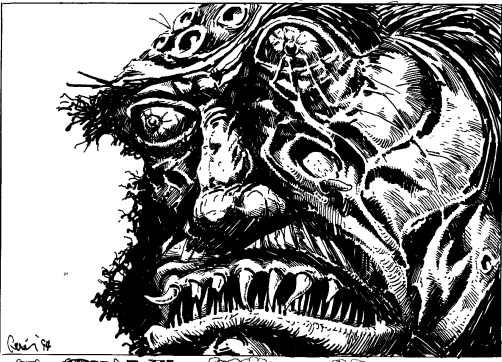
quote:
Fairly common in small towns before the advent of television blunted the imagination of the young
Way to start off judgey Whispering Vault. I bet you don’t even own a TV.
Despite the appearance these guys are some of the more benevolent Shadows, lurking around sleeping children to watch innocent dreams. Since many children are Sensitive they may catch glimpses, resulting in “monsters under the bed” stories. Alternatively they can befriend children, becoming “invisible friends” to them, only fully Awakening in response to trauma inflicted on their friends, becoming physical to avenge them.
On their own, they’re nasty looking but basically benevolent. They can be bound by the Unbidden to serve as Minions, usually in the Husk of a weird looking dog or a creepy child.
Stat-wise they’ll fuck a mortal up but aren’t much of a hazard to a Stalker.
Rethrett (Cameramen)
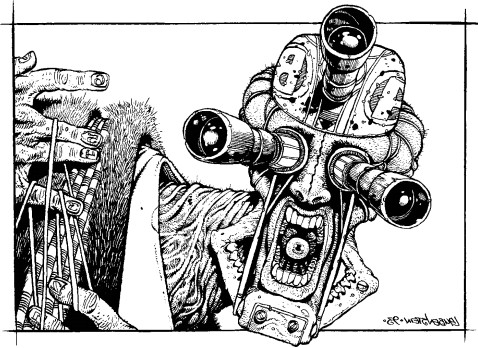
One of the most common forms of Shadows in the modern era, they are everywhere by the year 2000, except the UK since for some reason they seem to find the BBC unpleasant.
They live “inside” television sets, watching the watchers.
quote:
Cameramen are Awakened when a viewer loses the ability to distinguish between reality and the phantoms flickering past on the face of the electronic basilisk.
Did a TV grope you as a child Whispering Vault, you’re getting awfully preachy all of a sudden.
An Awakened Cameraman will constantly change shape with a jumble of wires and limbs (always at least 3), making them easy to fit into a Husk of whatever form. Since their perception stat is really high and they have perfect memories they’re mainly used as lookouts or watchdogs by the Unbidden. They’re also common as dirt in the modern age so it’s ridiculously easy to find one. Otherwise they’re not particularly impressive in combat.
Ghann Galowey (Hangmen)
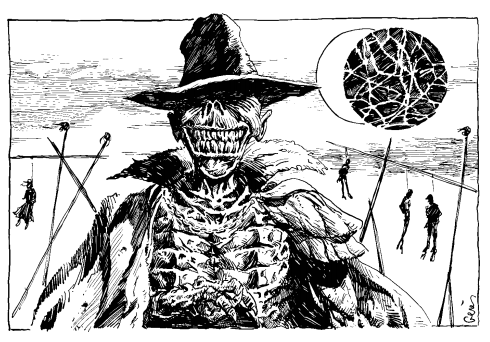
Hangmen are basically just generic slasher villians. They can be Awakened by an offering of blood and silver but after Awakening they must be “incubated” for three days in a fresh grave before rising at full power (like a murder Jesus!). They have two distinct personalities: a goofy, evil idiot and a cold-bloodeded serial killer type.
These guys are too unstable to be used for anything other than assassination and it’s largely pointless to stick them in a Husk as their behavior is too bizarre to pass for human. They fight with a hook and rope (which they can conjure at will). If they hit with the hook then they can try and noose a victim, which allows them to hang them from any nearby object or building that is suitable.
Thritch Kalvarr (Pain Mothers)

Your standard S&M cyborgs. They lurk in areas of civilization’s decline and can sometimes Awaken upon seeing a crime of passion and drinking the victim’s blood. They are notable in being able to Husk themselves through means of a technique called the Promethean Experiment which gives them a perfectly human Vessel. Their default Vessel is eyeless with translucent flesh.
They serve as your standard femme fatales for Unbidden. They have a unique armor mechanic (subtracting 12 from damage before comparing it to fortitude) and a weapon which does minor damage at first but increases the more the victim is struck. If the Pain Mother wounds a Stalker they suffer a reluctance to attack them (2 die penalty) and mortals are almost incapable of it. Stalkers with the Savage Discipline can knock off points of armor.
Sanguinalin (Lurkers)

Subway grabiods. These are creatures that are attracted to underground structures (so they’re quite common in modern times) and Awaken spontaneously with no pattern, at which point they start eating people. Considering their Awakening seems inevitable and they’re so damn common you’d think people would have noticed the subway krakens.
Lurkers have an entirely optional size, going from as small as a mouse to as large as a whale. Lurkers are popular “heavies” for Unbidden but they’ll burst their Husks every 2d6 days.
Despite being able to apparently attain whale-size Lurkers are not really impressive combatants (especially compared to the Behemoth). They have a lot of Vitality but really crappy Fortitude meaning that they’ll be shredded by a party of Stalkers in short order. Offensively they have two tentacle attacks which inflict only middling damage (although they may go berserk getting an extra attack and a bonus damage die which can make them nasty...if it didn’t inflict a major attack penalty).
Their size-changing ability isn’t actually mentioned in their stats, although they can apparently turn into liquid and they’re weakened in bright light.
Zelun Vhori (Ogyrs)
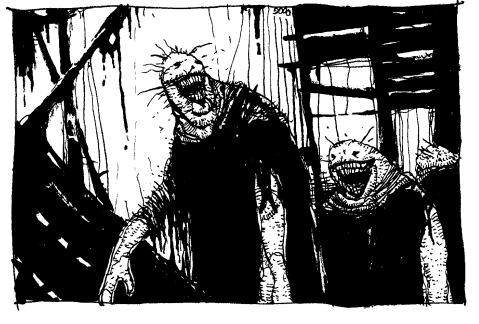
What is the point in spelling Ogre with a “y” if you’re already giving them a gibberish name?
Ogyrs are drawn to mortals and enjoying listening to them but are utterly terrified of being discovered by them, believing that they will die if discovered. This can lead them to panic and Awaken in an attempt to defend themselves. Awakened they are nasty on several levels with iron bones and pores that ooze infectious fluid. They normally decay within a few days unless sustained by specially prepared meals (a technique known by some Mortal Enlightened). Left to their own they’ll flee and hide somewhere until they rot to pieces. They are too stupid to be reasoned with but music may soothe or enrage them...so that’s helpful.
Ogyrs are the best muscle out there for Unbidden other than Behemoths but they don’t take to Husks well and scratch them off in 1d6 hours. They aren’t that tough but they’ve got lots of damage potential and have the ability to stun anyone they hit, making them lose their next action...meaning that one-on-one they’re practically unbeatable except for dedicated combat monsters. Especially since the Savage Discipline does no bonus damage to them (because reasons).
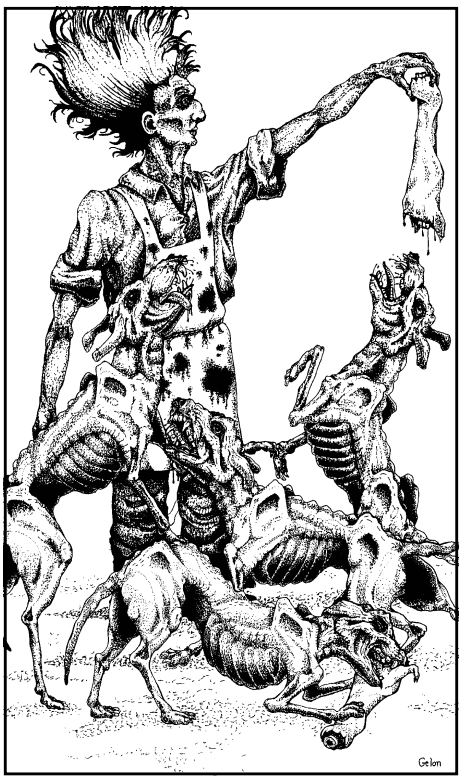
Unique Shadows
The previous example shadows are “races” or “breeds” of similar beings but many Shadows are unique entities formed from the...whatever...in the Rift. Unique Shadows have an interesting role as the only characters who aren’t pigeonholed by the game in some way. Stalkers hunt the Unbidden, the Unbidden try and remain free and mortals are largely inconsequential except as obstacles. Unique Shadows can have their own goals and, like Stalkers, exist outside of the normal timeline so they can be encountered in multiple Hunts for long term roleplaying. Theoretically they might be able to visit in the Realm of Essence (this aspect of Shadows is never addressed).
The book provides a few examples:
Shriekblack and Guzz
These two Shadow-bros have been together throughout the universe’s history. They’ve learned secrets from the Navigators about traveling the Chronosphere and apparently have a grudge against the Unbidden from a past bit of nastiness. As a result they’re happy to help Stalkers take them down. Shriekblack is an urbane, intelligent and versed in the occult. Guzz kills things.
Neither are quite on the level of one of the Unbidden in terms of danger but together they’re a decent challenge but likely they’d be smart enough to avoid the situation in the first place.
Abballor the Butcher of Baker Street
While Shriekblack and Guzz are meant to be weirdo allies or observers, Abballor is a recurring antagonist, a Shadow serial killer who can appear in any time period and is exceptionally difficult to kill permanently and re-Awakens very easily when defeated. Aballor is a combat brute with a damn impressive Vitality and lots of damage (not quite Behemoth level, but more than enough to fuck up a Stalker or two), plus the ability to regenerate Vitality at the cost of Resolve (which is a very high 21 to begin with).
Main problem with someone like Abballor is that since Stalkers only ever come to the Realm of Flesh for a Hunt they’re going to be in a very tough position if they have to take down Abballor and an Unbidden (remember, Stalkers can’t really heal). Abballor isn’t unbeatable but it will inflict heavy damage to a team’s Vitality and Karma supplies.